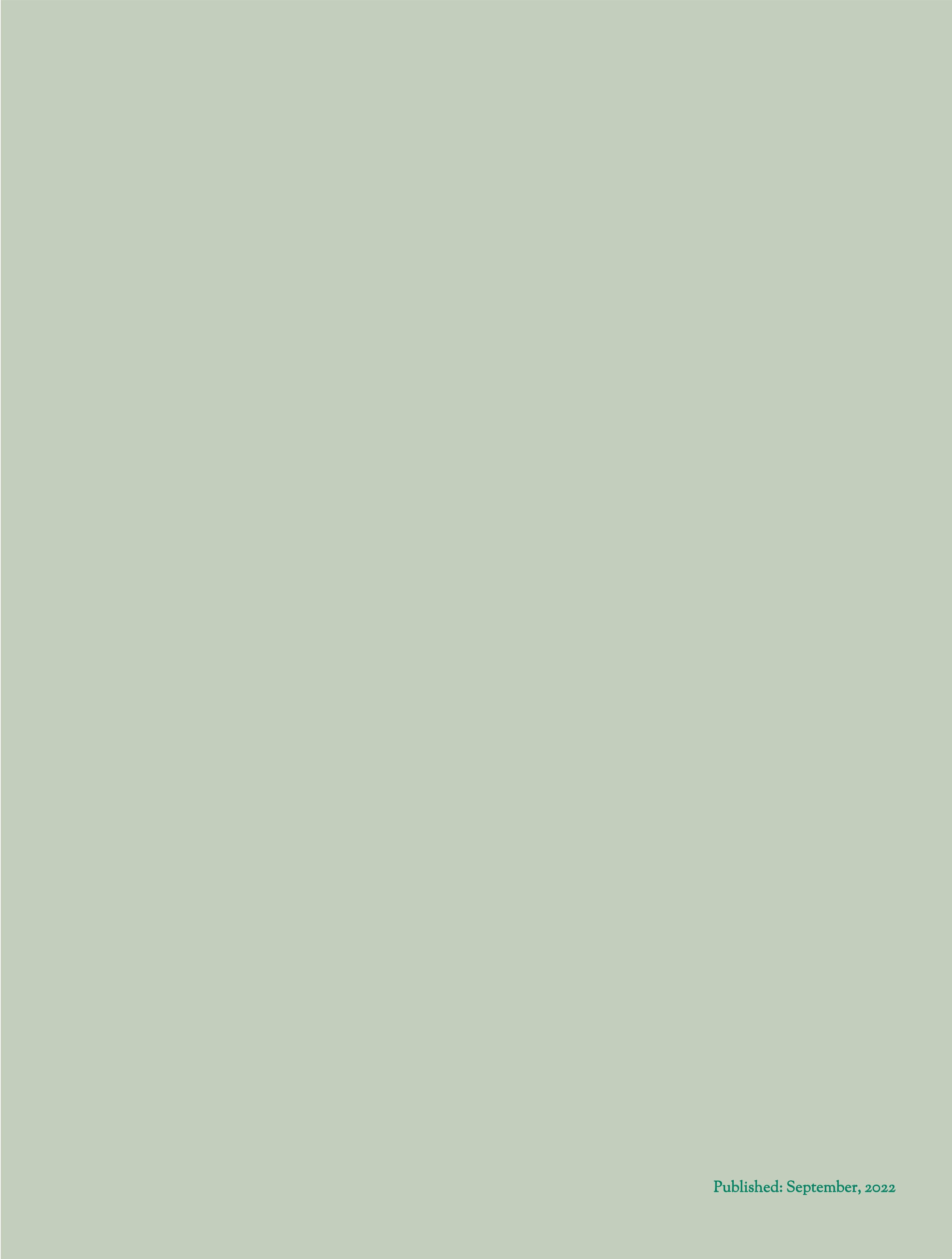
14TH TO 23RD OCTOBER 2022
MAYUYAMA & CO., LTD.
ごあいさつ
北斉から隋にかけての鉛釉の流行を基盤として、初唐、そして盛唐期に全盛期を迎 えることとなる三彩は、北朝文化の終着点とも云えます。白という色を尊んだ北朝の 人々は、隋において白磁を完成させ、隋から初唐にかけての白磁隆盛を生み出します。 その裏側で鉛釉陶器も漢以来の興隆をみせることとなります。
一般に三彩は武則天の治世より盛んになったと云われていますが、北斉の時点で完 成しているとも云え、そこから盛唐、武周の最盛期までには、百年以上の時が横たわっ ております。唐三彩は仏教と密接に関わっていた可能性が指摘されており、これは仏 教を重んじた武則天によるその擁立と三彩の流行が、時を同じくしていることからも 明らかかと思われます。従って、初唐、高宗の治世下で武照(武則天)が皇后となっ た655年を仏教及び唐三彩隆盛の起点とみることが可能ではないでしょうか。
本展には、そういった初唐後半のものと推定される作品に加え、北朝から隋、そし て初唐前半に至るまでの作品も出展されております。これにより北斉から盛唐に至る 三彩及び鉛釉の推移を把握する一助になればと思っております。
また器種においても、多種多様な作品を出陳いたします。中でも梅瓶、燭台、建築 明器類などは極めて珍しい作例と云えるでしょう。その他の作品も、同様の作例の中 で美的に秀抜なものを選びました。本展に出品される作品の殆どは、1910年代から 戦前期までに市場に出たと推察されるものです。これは本展を催すにあたってとくに
3
拘った点でもあります。 唐三彩のイメージはその発見より百年以上の時を経て、だいぶ固定化し形骸化して いるようにも思われます。個々の鑑賞者が感受性の扉を開き、自己の中に瑞々しい感 動と新たな可能性を見出す契機となれば幸いです。 令和4年10月 繭山龍泉堂
4 略年表 北周 隋 557 577 550 705 684 700 750 600 初 唐 盛 唐 550 535 西魏 東魏 北魏 534 - 655 武照(武則天)皇后となる - 659 長孫無忌ら自殺。武則天の権力確立 - 712 玄宗即位。開元の治始まる - 740 楊玉環(楊貴妃)、玄宗の後宮に入る - 751 タラス河畔の戦いでアッバース朝に大敗 - 651 サーサーン朝滅亡 - 627 玄奘三蔵、仏教の真理を求めインドへ - 645 玄奘帰国。翌646年に『大唐西域記』完成 - 682 洛陽を神都とする - 755 安史の乱起こる 618 隋煬帝討たれる。 李淵(高祖)、隋恭帝の禅譲を受け唐を建国 690 武則天即位。国号を周とする 梁 557 陳 587 554 756 武周 617 581 楊堅(文帝)、北周静帝の禅譲を受け隋を建国 仏教の復興に努める 589 陳 滅び隋中華統一 唐 中唐 650 628 北斉
Message
Sancai three-colored ceramics reached a golden age during China's Early Tang to High Tang eras, building from the basis of lead-glazed ceramic trends in the Northern Qi to Sui dynasties. Tang sancai wares are considered the final form of Northern Dynasties cultural expression. The color white was revered during the Northern Dynasties era. Sui dynasty potters perfected white porcelain technology, which ushered in the golden age of white porcelain from the Sui to Early Tang. Lead glazed ceramics constituted the flip-side of these porcelain developments and flourished from the Han dynasty onwards.
In general, sancai wares are thought to have been popular from Wu Zetian's reign onwards, while other theories think the ware type matured during the Northern Qi dynasty. Such dating would mean that sancai ware technology matured more than a century before the High Tang when Wu Zetian was at the height of her powers. A possible close connection between Tang sancai and Buddhism has also been noted. The simultaneous growth of Buddhism under Wu Zetian, a devout Buddhist, and the burgeoning sancai ware trend seems to further indicate such a connection. Thus we can suggest the year 655 when Wu Zhao (Zetian) was named empress consort during the reign of Gaozong as the pinnacle of both the flourishing of Buddhism in China and the Tang sancai trend.
In addition to works attributed to the latter half of the Early Tang era, this exhibition presents an array of items dating from the Northern Dynasties through the Sui and first half of the Early Tang. We hope this variety will provide visitors with an understanding of the changes that occurred in sancai and lead glazed wares from the Northern Qi through the High Tang.
We are also pleased to present a varied selection of vessel types and shapes in this exhibition, some rarely found in sancai, such as meiping jars, candlesticks and
5
architectural model grave goods. These examples and those of other vessel forms were all selected as particularly beautiful examples of their type. Most of the works displayed are thought to have appeared in the marketplace from the 1910s through the pre World War II era, and indeed, this provenance timing was another factor we considered when deciding which works to display in this exhibition.
The Tang sancai image has become all the more fixed and stereotypical over the century or more since its discovery by the modern world. It is our greatest hope that this exhibition will provide an opportunity for all visitors to fully discern the true beauty of Tang sancai, and through that experience, discover within themselves vibrant new sensations, new potential.
October 2022 Mayuyama & Co., Ltd.
6
Liang
Northern Wei
Western Wei Eastern Wei Chen
Chen state collapses, China unified under the Sui.
Northern Zhou Northern Qi
Northern Zhou emperor Jing abdication. Yang Jian (Emperor Wen) founds Sui dynasty. Buddhism promoted.
Emperor Yang of Sui defeated. Sui dynasty Gong abdicates. Li Yuan (Gaozu) founds Tang dynasty.
627 Xuanzhuan Sanzang to India seeking Buddhist truths.
Early Tang High Tang Middle Tang
645 Xuanzhuan returns to China. His travel record Datang xiyuji published in 646.
651 Southern Dynasties end.
655 Wu Zhao (Wu Zetian) made empress.
659 Suicide of Zhangsun Wuji. Wu Zetian solidifies power.
682 Luoyang named imperial capital.
Wu Zetian made Zhou dynasty empress regnant.
Sui Wu ZhouTang
712 Emperor Xuanzong named, Kaiyuan era begins.
Yang Yuhuan (Yang Guifei) becomes Xuanzong's concubine.
Tang forces defeated by Abbasid Caliphate at the Battle of Talas.
755 An Lushan Rebellion.
7 Brief Chronology
557 577 550 705 684 700 750 600 550 535 534 -
-
-
- 740
- 751
-
-
-
-
-
618 690
557 587 554 756 617 581 589 650 628
1. 緑釉杯
北朝〜隋(6〜7世紀)
高6.0 cm 口径8.5 cm 来歴
Sotheby & Co., ロンドン, 1955年5月24日.
Robert Stanley Hope Smith(1910〜1979年)旧蔵.
GREEN GLAZED CUP
Northern Dynasties - Sui dynasty (6th - 7th centuries) H. 6.0 cm Mouth Dia. 8.5 cm
PROVENANCE
Sotheby & Co., London, 24 May 1955.
Robert Stanley Hope Smith (1910-1979) Collection.
8

9
2. 三彩同心円文杯
隋〜初唐(7世紀)
高6.0 cm 口径7.6 cm
Alfred Clark(1873〜1950年)旧蔵. Alfred Clark夫人(1890〜1976年)旧蔵.
Spink & Son Ltd., ロンドン, 1975年.
「The Arts of the T’ang Dynasty」The Oriental Ceramic Society, ロンドン, 1955年, no. 113.
SANCAI CUP WITH CONCENTRIC CIRCLE DESIGN
Sui dynasty - Early Tang (7th century) H. 6.0 cm Mouth Dia. 7.6 cm
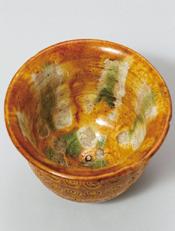
PROVENANCE
Alfred Clark (1873-1950) Collection. Mrs. Alfred Clark (1890-1976) Collection. Spink & Son Ltd., London, 1975.
EXHIBITED
The Arts of the T'ang Dynasty, The Oriental Ceramic Society, London, 1955, no. 113.
10
来歴
出展

11
3. 三彩梅
cm 胴径22.4 cm
Gian Francesco Giaquili Ferrini旧蔵.
Mario Prodan『La Poterie T’ang』Arts Et Métiers Graphiques, 1960年, 図版
SANCAI MEIPING JAR
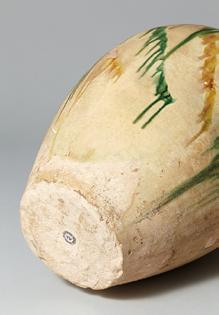
Sui dynasty - Early Tang (7th century) H. 31.5 cm Torso Dia. 22.4 cm
PROVENANCE
Gian Francesco Guiquili Ferrini Collection.
LITERATURE
Mario Prodan, La Poterie T'ang, Arts et Métiers Graphiques, 1960, Pl. Ⅵ
12
めいぴん 瓶 隋〜初唐(7世紀) 高31.5
来歴
所載
Ⅵ

13
4. 三彩花文燭台
初唐(7世紀)
高23.3 cm 径24.5 cm
Russell M. Tyson(1867〜1963年)旧蔵. The Art Institute of Chicagoに寄贈, シカゴ, 1951年.
弓場紀知『中国の陶磁 第三巻 三彩』平凡社, 1995年, 挿図65.
SANCAI LAMP WITH FLORAL DESIGN
Early Tang (7th century) H. 23.3 cm Dia. 24.5 cm
PROVENANCE
Russell M. Tyson (1867-1963) Collection. Gift to the Art Institute of Chicago, 1951.
LITERATURE
Yuba Tadanori, Sansai [Three-color ware], vol. 3 from the series Chūgoku no Tōji [Chinese Ceramics], Heibonsha, 1995, fig. 65.

14
来歴
所載

15

16

17
SANCAI ELEPHANT RHYTON
Tang (7th century)
EXHIBITED
Heisei Gannendo Tokubetsuten, Inki - Hai, Wan, Taku [Heisei 1 Special Exhibition Drinking Vessels − Cups, Bowls, Cup/Bowl Stands], Kuboso Memorial Museum of Arts, Izumi, Osaka, 1989, no. 123.
LITERATURE
Kamei Akinori, Research on Chinese Ceramic History, Rokuichi Shobo, 2014, p. 153, pls. 1-5a, 5b.

18 5. 三彩象形角杯 初唐(7世紀) 高7.2 cm 長10.7 cm 出展 「平成元年度特別展示 飲器−杯・碗・托−」和泉市久保惣記念美術館, 1989年, no. 123. 所載 亀井明徳『中国陶瓷史の研究』六一書房, 2014年, p. 153, 図版1-5a, 5b.
Early
H. 7.2 cm L. 10.7 cm

19
SANCAI ELEPHANT RHYTON

Tang (7th century)
cm L. 10.4
PROVENANCE
Box inscription by Sugimura Yūzō (1900-1978)
EXHIBITED
Heisei Gannendo Tokubetsuten, Inki - Hai, Wan, Taku [Heisei 1 Special Exhibition Drinking Vessels − Cups, Bowls, Cup/Bowl Stands], Kuboso Memorial Museum of Arts, Izumi, Osaka, 1989, no. 123.
20 6. 三彩象形角杯 初唐(7世紀) 高6.8 cm 長10.4 cm 来歴 杉村勇造(1900〜1978年)箱書. 出展 「平成元年度特別展示 飲器−杯・碗・托−」和泉市久保惣記念美術館, 1989年, no. 123.
Early
H. 6.8
cm

21
7. 三彩有蓋丸壺
初唐(7世紀)
高6.5 cm 胴径7.6 cm

Robert Stanley Hope Smith(1910〜1979年)旧蔵.
SANCAI ROUND JAR WITH LID
Early Tang (7th century) H. 6.5 cm Torso Dia. 7.6 cm
PROVENANCE
Robert Stanley Hope Smith (1910-1979) Collection.
22
来歴

23
8. 三彩騎象胡人燭台
初唐(7世紀) 高15.8 cm 長11.1 cm
SANCAI LAMP WITH WEST ASIAN FIGURE ON ELEPHANT
Early Tang (7th century) H. 15.8 cm L. 11.1 cm
24

25
9. 三彩加彩胡児
初唐(7世紀)
高30.0 cm
PAINTED SANCAI WEST ASIAN BOY
Early Tang (7th century) H. 30.0 cm
26

27
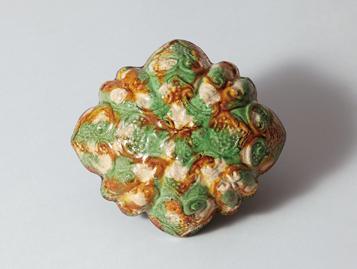
28 初唐(7世紀) 高4.3 cm 幅9.8 cm 来歴 Timmer-Kerkhoven夫人旧蔵, 1930〜1950年代に入手. 10. 三彩印花葡萄唐草文杯

29
SANCAI FOLIATE CUP WITH STAMPED GRAPES AND ARABESQUES DESIGN
Early Tang (7th century)
H. 4.3 cm W. 9.8 cm
PROVENANCE
Mrs. Timmer-Kerkhoven Collection, acquired 1930s-1950s.
30

31

32 11. 三彩印花円珠文杯 初唐(7世紀) 高4.0 cm 口径9.7 cm 来歴 Wilfrid Fleisher(1897〜1976年)旧蔵.
SANCAI CUP WITH IMPRESSED DOT DESIGN

Early Tang (7th century) H. 4.0 cm Mouth Dia. 9.7 cm
PROVENANCE
Wilfrid Fleisher (1897-1976) Collection.
33

34 12. 三彩印花花弁文杯 初唐(7世紀) 高4.0 cm 口径9.9 cm 来歴 Wilfrid Fleisher(1897〜1976年)旧蔵.
SANCAI CUP WITH IMPRESSED FLOWER PETAL DESIGN
Early Tang (7th century) H. 4.0 cm Mouth Dia. 9.9 cm

PROVENANCE
Wilfrid Fleisher (1897-1976) Collection.
35

36 13. 三彩印花花文杯 初唐(7世紀) 高3.8 cm 口径9.8 cm
SANCAI CUP WITH STAMPED FLOWER DESIGN
Early Tang (7th century) H. 3.8 cm Mouth Dia. 9.8 cm

37
三彩貼花鳳首瓶 重要美術品
初唐(7世紀)
cm 胴径16.6 cm
1930年代.
「東京帝室博物館復興開館記念陳列」東京帝室博物館, 1938年, 8室14函.
1960年, no.7.
1961年, no.7.
唐宋名陶展」白木屋, 1964年, no. 1.
「中国陶磁 美を鑑るこころ」泉屋博古館分館, 2006年, no. 10. 所載
『陶器圖錄 第七巻 支那篇[上]』雄山閣, 1938年, 図版31.
『陶磁』第十巻第五號, 東洋陶磁研究所, 1938年, p. 4. 奥田誠一, 広田不孤斎, 田中作太郎, 林屋晴三編『中国の陶磁』東都文化出版, 1955年, 挿図79. 座右寶刊行會編『世界陶磁全集 第9巻 隋唐篇』河出書房, 1956年, 図版53.
小山冨士夫編『中国名陶百選』日本経済新聞社, 1960年, p. 39.
座右寶刊行會編『世界陶磁全集 第九巻〈中國 隋唐篇〉』河出書房新社, 1961年, 図版53.
『陶説』日本陶磁協会, 133号, 1964年, 図版1.
『陶説』日本陶磁協会, 135号, 1964年, 図版1. 水野清一『陶器全集 第25巻 唐三彩』平凡社, 1965年, 図版1.
小山冨士夫編『日本の美術 第76号 三彩』至文堂, 1972年, 第90図.
三上次男「唐三彩鳳首パルメット文の水注とその周邊−唐三彩の性格に關する一考察−」『國華』國華 社, 960號, 1973年, 挿図6. 繭山龍泉堂『龍泉集芳 第一集』便利堂, 1976年, 図版225. 繭山順吉『美術商のよろこび』便利堂, 1988年, PLATE 11. 矢部良明『日本の美術 第408号 唐三彩と奈良三彩』至文堂, 2000年, 第6図. 矢部良明, 今井敦編『やきもの名鑑[6]中国の陶磁』講談社, 2000年, p. 17.
亀井明徳『中国陶瓷史の研究』六一書房, 2014年, p. 194, 図版4-41.
38 14.
高37.7
来歴 繭山龍泉堂,
森村義行(1896〜1970年)旧蔵. 出展
「中国名陶百選展」日本橋髙島屋,
「中国名陶百選展」大阪・なんば髙島屋,
「中国古陶磁
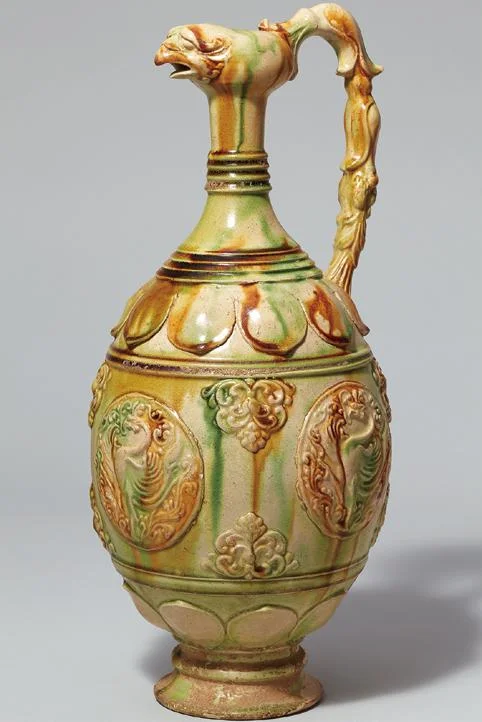
39
SANCAI PHOENIX HEAD EWER WITH APPLIQUE DESIGN Important Art Object
Early Tang (7th century)
H. 37.7 cm Torso Dia. 16.6 cm
PROVENANCE
Mayuyama & Co., Ltd., Tokyo, 1930s. Morimura Yoshiyuki (1896-1970) Collection.
EXHIBITED
Tokyo Teishitsu Hakubutsukan Fukkō Kaikan Ki'nen Chinretsu [Display Commemorating the Restoration of the Tokyo Imperial Museum], Tokyo Imperial Museum, Tokyo, 1938, Room 8, Case 14.
Chinese Ceramics, A Loan Exhibition of One Hundred Selected Masterpieces from Collections in Japan, England, France, and America, Nihonbashi Takashimaya, Tokyo, 1960, no. 7.
Chinese Ceramics, A Loan Exhibition of One Hundred Selected Masterpieces, OsakaNanba Takashimaya, Osaka, 1961, no. 7.
Chūgoku Kotōji, Tō Sō Meitōten [Chinese Antique Ceramics, Tang, Song Ceramic Masterpieces Exhibition], Shirokiya, Tokyo, 1964, no. 1.
Chinese Ceramics, Enlightening through Beauty, Sen-oku Hakukokan, Tokyo, 2006, no. 10.
LITERATURE
Shina Hen (jō) [China Pt. 1], vol. 7 from the series Tōki Zuroku [Ceramics Illustrated Catalogue], Yuzankaku, 1938, pl. 31.
Oriental Ceramics Vol. Ⅹ , No. 5, Institute of Oriental Ceramics, 1938, p. 4. Okuda Seiichi, Hirota Fukosai, Tanaka Sakutaro, Hayashiya Seizō, (eds.), Chūgoku no Tōji [Chinese Ceramics], Tōto Bunka Shuppan, 1955, fig. 79.
Zauhō Kankōkai (ed.), Zuitō hen [Sui-Tang], vol. 9 from the series Sekai Tōji Zenshū [Ceramic Art of the World], Kawade Shobo, 1956, pl. 53.
Koyama Fujio (ed.), Chinese Ceramics, A Loan Exhibition of One Hundred Selected master pieces from collections in Japan, England, France, and America, The Nihon Keizai, 1960, p. 39.
Zauhō Kankōkai (ed.), Sui-Tang, vol. 9 from the series Collection of World's Ceramics, Kawade Shobo Shinsha, 1961, fig. 53.
The Tosetsu, The Japan Ceramic Society, No. 133, 1964, pl. 1.
The Tosetsu, The Japan Ceramic Society, No. 135, 1964, pl. 1. Mizuno Seiichi, Tōsansai [Tang three-color ware], vol. 25 from the series Tōki Zenshū [Complete Collection of Pottery], Heibonsha, 1965, pl. 1.
Koyama Fujio, ed., Sansai [Three-color ware], vol. 76 from the series Nihon no Bijutsu [Arts of Japan], Shibundo, 1972, pl. 90.
Mikami Tsugio, "A T'ang Three-color Ewer with Applied Palmette Medallions and the Character of T'ang Three-color Ware", Kokka, No. 960, 1973, fig. 6.
Mayuyama & Co., Ltd., Mayuyama Seventy Years Vol. Ⅰ, Benrido, 1976, pl. 225.
Mayuyama Junkichi, The Joys of an Art Dealer, Benrido, 1988, pl. 11.
Yabe Yoshiaki, Tōsansai to Narasansai [Tang three-color ware and Nara three-color ware], Vol. 408 from the series Nihon no Bijutsu [Arts of Japan], Shibundō, 2000, pl. 6.
Yabe Yoshiaki, Imai Atsushi, (ed), Chūgoku no Tōji [Chinese Ceramics], vol. 6 from the series of Yakimono Mēkan [Ceramic Directory], Kodansha, 2000, p. 17.
Kamei Akinori, Researches on Chinese Ceramic History, Rokuichi Shobo, 2014, p. 194, pl. 4-41.
40

41
15. 三彩万年壺
初唐〜盛唐(7世紀)
高13.1 cm 胴径18.5 cm
C. T. Loo & Co., パリ. Marie-Rose Loo旧蔵.
Gian Francesco Giaquili Ferrini旧蔵.
SANCAI JAR

Early Tang - High Tang (7th century) H. 13.1 cm Torso Dia. 18.5 cm
PROVENANCE
C. T. Loo & Co., Paris. Marie-Rose Loo Collection.
Gian Francesco Giaquili Ferrini Collection.
42
来歴

43
16. 三彩兔耳壺
初唐〜盛唐(7世紀)
cm 幅20.3
Gian Francesco Giaquili Ferrini旧蔵.
Mario Prodan『La Poterie T’ang』Arts Et Métiers Graphiques, 1960年, 図版
2014年, p. 185, 挿図3-22.
SANCAI JAR WITH RABBIT LUGS
Early Tang - High Tang (7th century) H. 18.5 cm W. 20.3 cm
PROVENANCE
Gian Francesco Guiquili Ferrini Collection.
LITERATURE
Mario Prodan, La Poterie T'ang, Arts et Métiers Graphiques, 1960, pl.
Kamei Akinori, Researches on Chinese Ceramic History, Rokuichi Shobo, 2014, p. 185, pl. 3-22.
44
高18.5
cm 来歴
所載
ⅩⅩⅩ 亀井明徳『中国陶瓷史の研究』六一書房,
ⅩⅩⅩ

45
17. 三彩把手杯
初唐(7世紀)
高6.3 cm 幅9.7 cm
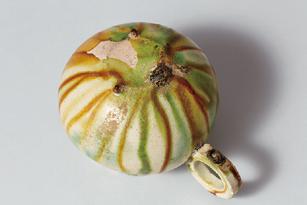
SANCAI CUP WITH HANDLE
Early Tang (7th century) H. 6.3 cm W. 9.7 cm
46

47
18. 三彩丸壺
cm
SANCAI ROUND JAR
Early Tang - High Tang (7th century) H. 7.5 cm Torso Dia. 11.0 cm
PROVENANCE
Kochukyo, Tokyo. Sugiyama Tōjudō, Tokyo.
48
初唐〜盛唐(7世紀) 高7.5 cm 胴径11.0
来歴 壺中居. 杉山陶樹堂.

49
19. 三彩五足炉
初唐〜盛唐(7世紀) 高8.4 cm 幅14.4 cm
SANCAI INCENSE BURNER WITH FIVE ANIMAL-SHAPED LEGS
Early Tang - High Tang (7th century) H. 8.4 cm W. 14.4 cm

50

51
20. 三彩五足炉
初唐〜盛唐(7世紀) 高9.8 cm 口径15.1 cm
Stephen Junkunc Ⅲ(1904〜1978年)旧蔵.
SANCAI INCENSE BURNER WITH FIVE ANIMAL MASK LEGS
Early Tang - High Tang (7th century) H. 9.8 cm Mouth Dia. 15.1 cm
PROVENANCE
Stephen Junkunc Ⅲ (1904-1978) Collection.
52
来歴

53
21. 三彩杯及び承盤
初唐〜盛唐(7世紀)
盤:高5.0 cm 径24.8 cm 杯(大):高4.0 cm 口径7.5 cm
繭山龍泉堂, 1950年代.
SANCAI CUPS AND TRAY
Early Tang - High Tang (7th century)
Tray: H. 5.0 cm Dia. 24.8 cm
Cup (Large): H. 4.0 cm Mouth Dia. 7.5 cm
PROVENANCE
Mayuyama & Co., Ltd., Tokyo, 1950s.
54
来歴

55

56 22. 三彩弁口水注 初唐〜盛唐(7世紀) 高9.0 cm 胴径6.5 cm SANCAI EWER WITH PETAL-MOUTH Early Tang - High Tang (7th century) H. 9.0 cm Torso Dia. 6.5 cm
23. 三彩貼花四耳壺
初唐〜盛唐(7世紀)
高5.6 cm 胴径4.3 cm
SANCAI JAR WITH FOUR HANDLES AND APPLIQUE DESIGN

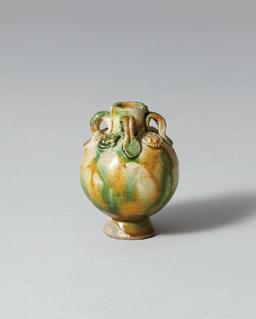
Early Tang - High Tang (7th century) H. 5.6 cm Torso Dia. 4.3 cm
24. 三彩丸壺
初唐〜盛唐(7世紀)
高5.3 cm 胴径7.7 cm
SANCAI ROUND JAR
Early Tang - High Tang (7th century) H. 5.3 cm Torso Dia. 7.7 cm
57
初唐〜盛唐(7世紀) 高11.2 cm 幅16.6 cm
Bluett & Sons, ロンドン. Gian Francesco Giaquili Ferrini旧蔵.
58 25. 絞 こうたいふく 胎
来歴

59
MARBLED CLAY FU TRIPOD VESSEL
Early Tang - High Tang (7th century) H. 11.2 cm W. 16.6 cm
PROVENANCE
Bluett & Sons, London.
Gian Francesco Giaquili Ferrini Collection.
60

61
黄釉絞
胎象嵌花文枕
1988年, no. 45.
1963年, no. 64.
1966年, no. 57.
1976年, no. 1-165.
第9巻 隋唐篇』河出書房, 1956年, 図版96下.
座右寶刊行會編『世界陶磁全集 第九巻〈中國 隋唐篇〉』河出書房新社, 1961年, 図版96下. 繭山龍泉堂『龍泉集芳 第一集』便利堂, 1976年, 図版304.
大阪市立美術館編『隋唐の美術』平凡社, 1978年, 図版148 (B).
佐藤雅彦『中国陶磁史』平凡社, 1978年, 挿図 113.
亀井明徳『中国陶瓷史の研究』六一書房, 2014年, p. 236, 挿図2-25.
YELLOW GLAZED MARBLED CLAY PILLOW WITH INLAID FLOWER DESIGN
High Tang (7th century) H. 5.1 cm L. 10.7 cm
PROVENANCE
Moriya Kōzō (1876-1953) Collection. Mayuyama & Co., Ltd., Tokyo.
EXHIBITED
Chūgoku Sōdai Tōchinten [Chinese Song dynasty ceramic pillows], Kanagawa Prefectural Museum of Modern Art, Kanagawa, 1963, no. 64.
Chūgoku Tōji Meihōten Shiri-zu II Sansai [Chinese Ceramic Treasures II Three-color ware], The Gotoh Museum, Tokyo, 1966, no. 57.
Zuitō no Bijutsu [Arts of the Sui and Tang], Osaka City Museum of Fine Art, Osaka, 1976, no. 1-165.
Tang Pottery and Porcelain, Nezu Institute of Fine Arts, Tokyo, 1988, no. 45.
LITERATURE
Zauhō Kankōkai (ed.), Zuitō Hen [Sui-Tang], vol. 9 from the series Sekai Tōji Zenshū [Ceramic Art of the World], Kawade Shobo, 1956, pl. 96, lower.
Zauhō Kankōkai (ed.), Sui-Tang, vol. 9 from the series Collection of World's Ceramics, Kawade Shobo Shinsha, 1961, pl. 96, lower.
Mayuyama & Co., Ltd., Mayuyama Seventy Years Vol. Ⅰ , Benrido, 1976, p. 304.
Osaka City Museum of Fine Art (eds.), Zuitō no Bijutsu [Arts of the Sui and Tang], Heibonsha, 1978, pl. 148 (B).
Satō Masahiko, Chūgoku Tōjishi [History of Chinese Ceramics], Heibonsha, 1978, fig. 113. Kamei Akinori, Researches on Chinese Ceramic History, Rokuichi Shobo, 2014, p. 236 pl. 2-25.
62 26.
こうたいぞうがん
盛唐(7世紀) 高5.1 cm 長10.7 cm 来歴 守屋孝蔵(1876〜1953年)旧蔵. 繭山龍泉堂. 出展 「中国宋代陶枕展」神奈川県立近代美術館,
「中国陶磁名宝展シリーズII 三彩」五島美術館,
「中国美術展シリーズ3 隋唐の美術」大阪市立美術館,
「唐磁」根津美術館,
所載 座右寶刊行會編『世界陶磁全集

63
27. 三彩印花花文枕
SANCAI PILLOW WITH STAMPED FLOWER DESIGN
High Tang (7th - 8th centuries) H. 5.2 cm W. 10.9 cm
PROVENANCE
Mayuyama & Co., Ltd., Tokyo, 1958.
LITERATURE
Zauhō Kankōkai (ed.), Zuitō hen [Sui-Tang], vol. 9 from the series Sekai Tōji Zenshū [Ceramic Art of the World], Kawade Shobo, 1956, fig. 107. Zauhō Kankōkai (ed.), Sui-Tang, vol. 9 from the series Collection of World's Ceramics, Kawade Shobo Shinsha, 1961, fig. 107. Mizuno Seiichi, Tōsansai [Tang three-color ware], vol. 35 from the series Tōji Taikei [Great Lineage of Pottery], Heibonsha, 1977, pl. 89.
64
盛唐(7〜8世紀) 高5.2 cm 長10.9 cm 来歴 繭山龍泉堂, 1958年. 所載 座右寶刊行會編『世界陶磁全集 第9巻 隋唐篇』河出書房, 1956年, 挿図107. 座右寶刊行會編『世界陶磁全集 第九巻〈中國 隋唐篇〉』河出書房新社, 1961年, 挿図107. 水野清一『陶磁大系 第三五巻 唐三彩』平凡社, 1977年, 図版89.

65
28. 緑釉象
嵌花文枕
盛唐(7〜8世紀) 高5.0 cm 長10.9 cm
GREEN GLAZED PILLOW WITH INLAID FLOWER DESIGN
High Tang (7th - 8th centuries) H. 5.0 cm L. 10.9 cm
66
ぞうがん

67
三彩象
SANCAI GLAZED PILLOW WITH INLAID FLOWER DESIGN
High Tang (7th - 8th centuries) H. 5.6 cm L. 11.6 cm
PROVENANCE
Kochukyo, Tokyo.
EXHIBITED
Chūgoku Sōdai Tōchinten [Chinese Song dynasty ceramic pillows], Kanagawa Prefectural Museum of Modern Art, Kanagawa, 1963, no. 63.
68 29.
ぞうがん 嵌花文枕 盛唐(7〜8世紀) 高5.6 cm 長11.6 cm 来歴 壺中居. 出展 「中国宋代陶枕展」神奈川県立近代美術館, 1963年, no. 63.

69
30. 三彩花文枕
盛唐(8世紀)
高5.6 cm 長12.2 cm
SANCAI PILLOW WITH FLOWER DESIGN
High Tang (8th century) H. 5.6 cm L. 12.2 cm
70

71
31. 褐釉絞
胎枕
盛唐(7〜8世紀) 高6.6 cm 長12.8 cm
1959年, 香港にて購入.
AMBER GLAZED MARBLED CLAY PILLOW
High Tang (7th - 8th centuries) H. 6.6 cm L. 12.8 cm
PROVENANCE
A previous owner purchased in Hong Kong, 1959.
72
こうたい
来歴

73
32. 三彩屋舎
盛唐(7〜8世紀) 高23.6 cm 幅25.6 cm
Collins & Moffat Chinese Antiques, シアトル, 1954年. John Yeon(1910〜1994年)旧蔵.

74
来歴

75
SANCAI HOUSE
High Tang (7th - 8th centuries) H. 23.6 cm W. 25.6 cm
PROVENANCE
Collins & Moffat Chinese Antiques, Seattle, 1954. John Yeon (1910-1994) Collection.
76

77
33. 三彩穀倉
1961年, 挿図152. 水野清一『陶器全集 第25巻 唐三彩』平凡社, 1965年, 図版49上.
佐藤雅彦『中国の土偶』美術出版社, 1965年, 図版153.
水野清一『陶磁大系 第三五巻
1977年,
SANCAI GRANARY
High Tang (7th - 8th centuries) H. 13.8 cm L.14.2 cm (including a stand)
PROVENANCE
Hosokawa Moritatsu (1883-1970) Collection. Kochukyo, Tokyo.
LITERATURE
Otsuka Minoru, Catalogue of Old Chinese Clay Wares and Images, Part 6, Ohtsuka Kogeisha, 1938, pl. 57 center left.
Zauhō Kankōkai (ed.), Zuitō hen [Sui-Tang], vol. 9 from the series Sekai Tōji Zenshū [Ceramic Art of the World], Kawade Shobo, 1956, fig. 152.
Zauhō Kankōkai (ed.), Sui-Tang, vol. 9 from the series Collection of World's Ceramics, Kawade Shobo Shinsha, 1961, fig. 152.
Mizuno Seiichi, Tōsansai [Tang three-color ware], vol. 25 from the series Tōki Zenshū [Complete Collection of Pottery], Heibonsha, 1965, pl. 49 upper.
Satō Masahiko, Chūgoku no Dogū [Chinese Figurine], Bijutsu Shuppansha, 1965, pl. 153.
Mizuno Seiichi, Tōsansai [Tang three-color ware], vol. 35 from the series Tōji Taikei [Great Lineage of Pottery], Heibonsha, 1977, fig. 41.
Mikami Tsugio, Chūgoku Ⅰ , kodai [China 1, Antiquity], vol. 5 from the series Tōki Kōza [Lectures on Pottery], Yuzankaku Shuppan, 1982, pl. 118 center.
78
盛唐(7〜8世紀) 高13.8 cm 幅14.2 cm(台含む) 来歴 細川護立(1883〜1970年)旧蔵. 壺中居. 所載 大塚稔『支那古明器泥像圖鑑 第六輯』大塚巧藝社, 1938年, 図版57中左. 座右寶刊行會編『世界陶磁全集 第9巻 隋唐篇』河出書房, 1956年, 挿図152. 座右寶刊行會編『世界陶磁全集 第九巻〈中國 隋唐篇〉』河出書房新社,
唐三彩』平凡社,
挿図41. 三上次男『陶器講座 第5巻 中国Ⅰ 古代』雄山閣出版, 1982年, 図版118中.

79
三彩 舂
図版49下.
第三五巻 唐三彩』平凡社, 1977年, 図版95.
1982年, 図版118上.
SANCAI CHONGCHU THRESHING EQUIPMENT
High Tang (7th - 8th centuries) H. 6.4 cm L. 17.9 cm
LITERATURE
Zauhō Kankōkai (ed.), Zuitō hen [Sui-Tang], vol. 9 from the series Sekai Tōji Zenshū [Ceramic Art of the World], Kawade Shobo, 1956, fig. 155.
Zauhō Kankōkai (ed.), Sui-Tang, vol. 9 from the series Collection of World's Ceramics, Kawade Shobo Shinsha, 1961, fig. 155.
Mizuno Seiichi, Tōsansai [Tang three-color ware], vol. 25 from the series Tōki Zenshū [Complete Collection of Pottery], Heibonsha, 1965, pl. 49 lower.
Mizuno Seiichi, Tōsansai [Tang three-color ware], vol. 35 from the series Tōji Taikei [Great Lineage of Pottery], Heibonsha, 1977, pl. 95.
Mikami Tsugio, Chūgoku Ⅰ , Kodai [China 1, Antiquity], vol. 5 from the series Tōki Kōza [Lectures on Pottery], Yuzankaku Shuppan, 1982, pl. 118, upper.
80 34.
しょうしょ 杵 盛唐(7〜8世紀) 高6.4 cm 長17.9 cm 所載 座右寶刊行會編『世界陶磁全集 第9巻 隋唐篇』河出書房, 1956年, 挿図155. 座右寶刊行會編『世界陶磁全集 第九巻〈中國 隋唐篇〉』河出書房新社, 1961年, 挿図155. 水野清一『陶器全集 第25巻 唐三彩』平凡社, 1965年,
水野清一『陶磁大系
三上次男『陶器講座 第5巻 中国Ⅰ 古代』雄山閣出版,

81
SANCAI WELLHEAD
High Tang (7th - 8th centuries) H. 5.7 cm W. 9.7 cm
PROVENANCE Kochukyo, Tokyo.
LITERATURE
Zauhō Kankōkai (ed.), Zuitō hen [Sui-Tang], vol. 9 from the series Sekai Tōji Zenshū [Ceramic Art of the World], Kawade Shobo, 1956, pl 130 upper.
Zauhō Kankōkai (ed.), Sui-Tang, vol. 9 from the series Collection of World's Ceramics, Kawade Shobo Shinsha, 1961, fig. 130 upper.
Mizuno Seiichi, Tōsansai [Tang three-color ware], vol. 25 from the series Tōki Zenshū [Complete Collection of Pottery], Heibonsha, 1965, pl. 48 upper.
Satō Masahiko, Chūgoku no Dogū [Chinese Figurines], Bijutsu Shuppansha, 1965, pl. 153.
Mizuno Seiichi, Tōsansai [Tang three-color ware], vol. 35 from the series Tōji Taikei [Great Lineage of Pottery], Heibonsha, 1977, pl. 96.
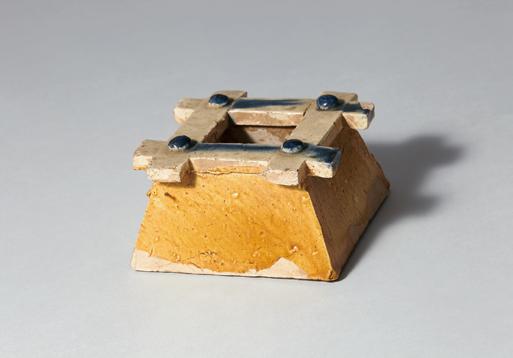
82 35. 三彩井 せいらん 欄 盛唐(7〜8世紀) 高5.7 cm 一辺9.7 cm 来歴 壺中居. 所載 座右寶刊行會編『世界陶磁全集 第9巻 隋唐篇』河出書房, 1956年, 図版130上. 座右寶刊行會編『世界陶磁全集 第九巻〈中國 隋唐篇〉』河出 書房新社, 1961年, 図版130上. 水野清一『陶器全集 第25巻 唐三彩』平凡社, 1965年, 図 版48上. 佐藤雅彦『中国の土偶』美術出版社, 1965年, 図版153. 水野清一『陶磁大系 第三五巻 唐三彩』平凡社, 1977年, 図 版96.
SANCAI WELLHEAD
High Tang (7th - 8th centuries) H. 6.7 cm W. 9.3 cm

PROVENANCE Kochukyo, Tokyo.
LITERATURE
Zauhō Kankōkai (ed.), Zuitō hen [Sui-Tang], vol. 9 from the series Sekai Tōji Zenshū [Ceramic Art of the World], Kawade Shobo, 1956, pl. 130 lower.
Zauhō Kankōkai (ed.), Sui-Tang, vol. 9 from the series Collection of World's Ceramics, Kawade Shobo Shinsha, 1961, fig. 130 lower.
83 36. 三彩井 せいらん 欄 盛唐(7〜8世紀) 高6.7 cm 一辺9.3 cm 来歴 壺中居. 所載 座右寶刊行會編『世界陶磁全集 第9巻 隋唐篇』河出書房, 1956年, 図版130下. 座右寶刊行會編『世界陶磁全集 第九巻〈中國 隋唐篇〉』河出 書房新社, 1961年, 図版130下.

84 37. 黄釉褐彩鴨 盛唐(7世紀) 高8.9 cm 幅9.0 cm 来歴 Wilfrid Fleisher(1897〜1976年)旧蔵. AMBER PAINTED YELLOW GLAZED DUCK High Tang (7th century) H. 8.9 cm L. 9.0 cm PROVENANCE Wilfrid Fleisher (1897-1976) Collection.
38. 褐釉犬
盛唐(7世紀)
高11.8 cm 幅5.2 cm
来歴 Wilfrid Fleisher(1897〜1976年)旧蔵.
AMBER GLAZED DOG
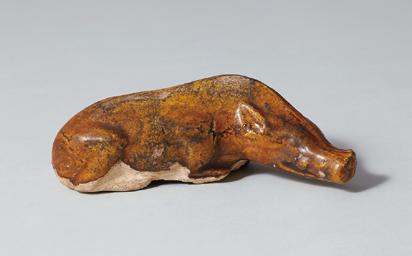

High Tang (7th century) H. 11.8 cm W. 5.2 cm
PROVENANCE
Wilfrid Fleisher (1897-1976) Collection.
39. 褐釉猪
盛唐(7世紀)
高4.6 cm 長12.8 cm 来歴 Wilfrid Fleisher(1897〜1976年)旧蔵.
AMBER GLAZED WILD BOAR
High Tang (7th century) H. 4.6 cm L. 12.8 cm
PROVENANCE
Wilfrid Fleisher (1897-1976) Collection.
85
40. 黄褐釉加彩騎馬胡人
盛唐(7世紀) 高37.0 cm 長32.0 cm
Gian Francesco Giaquili Ferrini旧蔵.
Gian Francesco Giaquili Ferrini『Dal Neolitico al Sung』1976年, 図版 Ⅷ
PAINTED YELLOW AND AMBER GLAZED WEST ASIAN FIGURE ON HORSEBACK
High Tang (7th century) H. 37.0 cm L. 32.0 cm
PROVENANCE
Gian Francesco Giaquili Ferrini Collection.
LITERATURE
Gian Francesco Giaquili Ferrini, Dal Neolitico al Sung, 1976, pl. Ⅷ
86
来歴
所載

87
41. 褐釉白斑文馬
盛唐(7〜8世紀)
高52.5 cm 長47.5 cm
Joseph Winterbotham Jr.(1878〜1954年)旧蔵. The Art Institute of Chicagoに寄贈, シカゴ, 1954年.
AMBER GLAZED AND WHITE SPOTTED HORSE
High Tang (7th - 8th centuries) H. 52.5 cm W. 47.5 cm
PROVENANCE
Joseph Winterbotham, Jr. (1878-1954) Collection. Gift to the Art Institute of Chicago, 1954.
88
来歴

89
42. 黄釉褐彩駱駝
盛唐(7〜8世紀)
高51.3 cm 長35.0 cm
Wilfrid Fleisher(1897〜1976年)旧蔵.
Alf Liedholm「Tokio-Stockholm. Hos Mr Och Mrs Wilfrid Fleisher」『Svenska Hem och Trädgårdstidningen』Nr 3, Årg. 44, 1956年, pp. 61-63.
YELLOW GLAZED AMBER PAINTED CAMEL
High Tang (7th - 8th centuries) H. 51.3 cm L. 35.0 cm
PROVENANCE
Wilfrid Fleisher (1897-1976) Collection.
LITERATURE
Alf Liedholm, "Tokio-Stockholm, Hos Mr Och Mrs Wilfrid Fleisher", Svenska Hem och Tradgardstidningen, Nr. 3, Arg. 44, 1956, pp. 61-63.
90
来歴
所載

91
43. 三彩鎮墓獣
盛唐(7世紀)
高95.0 cm 幅31.0 cm
Bertha Palmer Thorne(1911〜1974年)旧蔵.
Pauline Palmer Wood(1917〜1984年)旧蔵.
The Art Institute of Chicagoに寄贈, シカゴ, 1970年.
92
来歴

SANCAI TOMB GUARDIAN BEAST
High Tang (7th century) H. 95.0 cm W. 31.0 cm
PROVENANCE
Bertha Palmer Thorne (1911-1974) Collection. Pauline Palmer Wood (1917-1984) Collection. Gift to the Art Institute of Chicago, 1970.
94
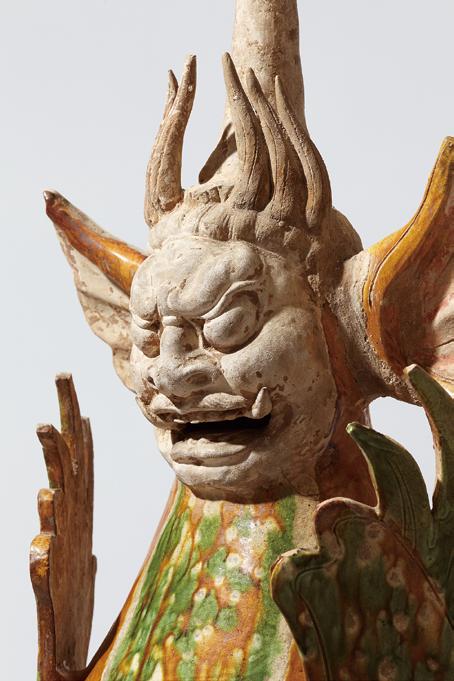
95
44. 三彩馬

96

97
44. 三彩馬
SANCAI HORSE High Tang (7th - 8th centuries) H. 68.0 cm L. 79.0 cm
PROVENANCE
Matsuoka Family Collection, Kanazawa. The Chinese Ceramics Museum, Oita.
EXHIBITED
Kaikan 5shūnen Kinen, Chūgoku no Yakimono - Kan, Tō, Sō, Min [Exhibition Commemorating 5th Anniversary of the Museum Opening, Chinese Ceramics - Han, Tang, Song, Ming], Ishikawa Prefectural Museum of Art, Ishikawa, 1964, no. 17.
LITERATURE
Chūgoku Tōji Bijutsukan Zōhin Senshū [Selected Works from the Chinese Ceramics Museum Collection], The Chinese Ceramics Museum, 2005, pl. 21. −Yō, Tō, Ka− Kanzō Yūhin Senshū [Figurines, Ceramics from Song to Yuan, and Porcelain from Ming to Qing, Selected Masterpieces from the Museum Collection], The Chinese Ceramics Museum, 2005, pl. 7.
98
盛唐(7〜8世紀) 高68.0 cm 長79.0 cm 来歴 松岡家(金沢)旧蔵. 中國陶瓷美術館. 出展 「開館5周年記念 中國のやきもの 漢・唐・宋・明」石川県立美術館, 1964年, no. 17. 所載 『中國陶瓷美術館蔵品撰集』中國陶瓷美術館, 2005年, 図版21. 『−俑・陶・華− 館蔵優品撰集』中國陶瓷美術館, 2005年, 図版7.

99
100 45. 三彩女子 盛唐(7世紀) 高29.8 cm 来歴 繭山松太郎(1882〜1935年)が1920年代に北京にて購入. 杉山陶樹堂. 繭山龍泉堂.

101
SANCAI FEMALE FIGURINE
High Tang (7th century) H. 29.8 cm
PROVENANCE
Purchased by Mayuyama Matsutarō (1882-1935) in Beijing, 1920s. Sugiyama Tōjudō, Tokyo. Mayuyama & Co., Ltd., Tokyo.
102

103
46. 三彩胡服童子
盛唐(8世紀)
高42.8 cm
Gian Francesco Giaquili Ferrini旧蔵. John Sparks Ltd., ロンドン.
SANCAI YOUTH IN WEST ASIAN DRESS
High Tang (8th century) H. 42.8 cm
PROVENANCE
Gian Francesco Giaquili Ferrini Collection. John Sparks Ltd., London.
104
来歴

105
47. 三彩洗
SANCAI BASIN
High Tang (7th - 8th centuries) H. 2.6 cm Dia. 15.1 cm

PROVENANCE Kochukyo, Tokyo.
EXHIBITED
Chūgoku Bijutsuten Shiri-zu 3 [Chinese Art Exhibitions Series No. 3], Zuitō no Bijutsu [Art of the Sui and Tang], Osaka City Museum of Fine Art, Osaka, 1976, no. 1-123.
LITERATURE
Mizuno Seiichi, Tōsansai [Tang three-color ware], vol. 35 from the series Tōji Taikei [Great Lineage of Pottery], Heibonsha, 1977, pl. 61.
Osaka City Museum of Fine Art, eds., Zuitō no Bijutsu [Art of the Sui and Tang], Heibonsha, 1978, pl. 21.
106
盛唐(7〜8世紀) 高2.6 cm 径15.1 cm 来歴 壺中居. 出展 「中国美術展シリーズ3 隋唐の美術」大阪市立美術館, 1976年, no. 1-123. 所載 水野清一『陶磁大系 第三五巻 唐三彩』平凡社, 1977年, 図版61. 大阪市立美術館編『隋唐の美術』平凡社, 1978年, 図版21.

107
48. 三彩洗
盛唐(7〜8世紀)
SANCAI BASIN
High Tang (7th - 8th centuries) H. 4.2 cm Dia. 21.6 cm
PROVENANCE
Kochukyo, Tokyo.
Inoue Tsuneichi (1906-1965) Collection.
108
高4.2 cm 径21.6 cm 来歴 壺中居. 井上恒一(1906〜1965年)旧蔵.

109
盛唐(7〜8世紀)
高4.7 cm 径18.9 cm
Bluett & Sons, ロンドン.
Robert Stanley Hope Smith(1910〜1979年)旧蔵.
SANCAI TRIPOD TRAY WITH HŌSŌGE FLOWER DESIGN

High Tang (7th - 8th centuries)
H. 4.7 cm Dia. 18.9 cm
PROVENANCE
Bluett & Sons, London.
Robert Stanley Hope Smith (1910-1979) Collection.
110 49. 三彩宝相華文三足盤
来歴

111
三彩印花宝相華文洗
盛唐(7〜8世紀)
高5.7 cm 径23.5 cm
Rose Movius Palmer(1909〜2003年)旧蔵. The Art Institute of Chicagoに寄贈, シカゴ, 1976年.
SANCAI BASIN WITH STAMPED HŌSŌGE FLOWER DESIGN

High Tang (7th - 8th centuries)
H. 5.7 cm Dia. 23.5 cm
PROVENANCE
Rose Movius Palmer (1909-2003) Collection. Gift to the Art Institute of Chicago, 1976.
112
来歴
50.

113
高5.6 cm 径28.4 cm
Rose Movius Palmer(1909〜2003年)旧蔵. The Art Institute of Chicagoに寄贈, シカゴ, 1976年.
SANCAI TRIPOD TRAY WITH STAMPED FLYING BIRDS AND LOTUS LEAVES DESIGN
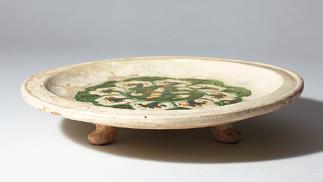
High Tang (7th - 8th centuries) H. 5.6 cm Dia. 28.4 cm
PROVENANCE
Rose Movius Palmer (1909-2003) Collection. Gift to the Art Institute of Chicago, 1976.
114 51. 三彩印花飛鳥蓮葉文三足盤 盛唐(7〜8世紀)
来歴

115
52. 三彩印花鴛
盛唐(7〜8世紀) 高2.6 cm 径14.9 cm
鴦連珠文洗
Kate Sturges Buckingham(1858〜1937年)旧蔵. The Art Institute of Chicagoに寄贈, シカゴ, 1928年.
SANCAI BASIN WITH STAMPED MANDARIN DUCKS AND PEARL CIRCLE DESIGN
High Tang (7th - 8th centuries) H. 2.6 cm Dia. 14.9 cm
PROVENANCE
Kate Sturges Buckingham (1858-1937) Collection. Gift to the Art Institute of Chicago, 1928.
116
えんおう
来歴

117
53. 三彩万年壺
盛唐(7〜8世紀)
高20.1 cm 胴径17.8 cm
Rolf Cunliffe(1899〜1963年)旧蔵. 出展
「Wares of the T’ang Dynasty」The Oriental Ceramic Society, ロンドン, 1949年, no. 26. 「The Arts of the T’ang Dynasty」The Oriental Ceramic Society, ロンドン, 1955年, no. 98.
The Oriental Ceramic Society『The Arts of the T’ang Dynasty』1955年, 図版7-h99.
SANCAI JAR
High Tang (7th - 8th centuries)
H. 20.1 cm Torso Dia. 17.8 cm
PROVENANCE
Rolf Cunliffe (1899 – 1963) Collection.
EXHIBITED
Wares of the T’ang Dynasty, The Oriental Ceramic Society, London, 1949, no. 26. The Arts of the T’ang Dynasty, The Oriental Ceramic Society, London, 1955, no. 98.
LITERATURE
The Oriental Ceramic Society, The Arts of the T’ang Dynasty, 1955, pl. 7-h99.
118
来歴
所載

119
54. 三彩有蓋万年壺
盛唐(8世紀)
cm 胴径21.6 cm
第15巻
1956年, 図版10.
1961年, 図版10.
1961年, 挿図79.
第一集』便利堂, 1976年, 図版248.
1977年, 図版43.
挿図94.
SANCAI JAR WITH LID
High Tang (8th century) H. 27.0 cm Torso Dia. 21.6 cm
LITERATURE
Zauhō Kankōkai (ed.), Zuitō hen [Sui-Tang], vol. 9 from the series Sekai Tōji Zenshū [Ceramic Art of the World], Kawade Shobo, 1956, pl. 10.
Zauhō Kankōkai (ed.), Sui-Tang, vol. 9 from the series Collection of World's Ceramics, Kawade Shobo Shinsha, 1961, pl. 10. Chūgoku (4) Zui Tō [China (4) Sui Tang], vol. 15 from the series Sekai Bijutsu Zenshū [Art of the World], Kadokawa Shoten, 1961, fig. 79. Mayuyama & Co., Ltd., Mayuyama Seventy Years Vol. Ⅰ , Benrido, 1976, pl. 248. Mizuno Seiichi, Tōsansai [Tang three-color ware], vol. 35 from the series Tōji Taikei [Great Lineage of Pottery], Heibonsha, 1977, pl. 43. Satō Masahiko, Chūgoku Tōjishi [History of Chinese Ceramics], Heibonsha, 1978, fig. 94.
120
高27.0
所載 座右寶刊行會編『世界陶磁全集 第9巻 隋唐篇』河出書房,
座右寶刊行會編『世界陶磁全集 第九巻〈中國 隋唐篇〉』河出書房新社,
『世界美術全集
中国(4)隋・唐』角川書店,
繭山龍泉堂『龍泉集芳
水野清一『陶磁大系 第35巻 唐三彩』平凡社,
佐藤雅彦『中国陶磁史』平凡社1978年,

121
55. 三彩万年壺
盛唐(8世紀)
高20.7 cm 胴径21.0 cm
Neill Malcom(1869〜1953年)旧蔵.
SANCAI JAR
High Tang (8th century) H. 20.7 cm Torso Dia. 21.0 cm
PROVENANCE
Neill Malcolm (1869-1953) Collection.
122
来歴

123
56. 褐釉弦文壺
盛唐(7〜8世紀)
高14.9 cm 胴径13.3 cm
Gian Francesco Giaquili Ferrini旧蔵. John Sparks Ltd., ロンドン.
AMBER GLAZED JAR WITH SHOULDER RIDGE
High Tang (7th - 8th centuries) H. 14.9 cm Torso Dia. 13.3 cm
PROVENANCE
Gian Francesco Guiquili Ferrini Collection. John Sparks Ltd., London.
124
来歴

125
57. 緑釉有蓋万年壺
盛唐(7〜8世紀) 高18.4 cm 胴径17.0 cm
GREEN GLAZED JAR WITH LID
High Tang (7th - 8th centuries) H. 18.4 cm Torso Dia. 17.0 cm
126

127
58. 藍釉洗
盛唐(7〜8世紀)
高3.4 cm 口径10.6 cm
Bluett & Sons, ロンドン.
A. Lionel Despointes旧蔵.
Sotheby & Co., ロンドン, 1954年, lot 6. Robert Stanley Hope Smith(1910〜1979年)旧蔵.
「Exhibition of Wares of the T’ang Dynasty」The Oriental Ceramic Society, ロンドン, 1949年, no. 116.
BLUE GLAZED BASIN
High Tang (7th - 8th centuries)
H. 3.4 cm Mouth Dia. 10.6 cm
PROVENANCE
Bluett & Sons, London.
A. Lionel Despointes Collection.
Sotheby & Co., London, 1954, lot 6. Robert Stanly Hope Smith (1910-1979) Collection.
EXHIBITED
Exhibition of Wares of the T'ang Dynasty, The Oriental Ceramic Society, London, 1949, no. 116.
128
来歴
出展

129
59. 三
彩
盛唐(7〜8世紀)
高7.2 cm 幅9.5 cm
C. T. Loo & Co., パリ, 1949年4月10日.
Bluett & Sons, ロンドン, 1949年6月9日.
Rolf Cunliffe(1899〜1963年)旧蔵.
「The Arts of the T’ang Dynasty」The Oriental Ceramic Society, ロンドン, 1955年, no. 101.
SANCAI FU TRIPOD VESSEL
High Tang (7th - 8th centuries) H. 7.2 cm W. 9.5 cm
PROVENANCE
C. T. Loo & Co., Paris, 10 April 1949.
Bluett & Sons, London, 9 June 1949.
Rolf Cunliffe (1899-1963) Collection.
EXHIBITED
The Arts of the T'ang Dynasty, The Oriental Ceramic Society, London, 1955, no. 101.
130
ふく
来歴
出展

131
FU TRIPOD VESSEL WITH BLUE PIGMENT

High Tang (7th - 8th centuries) H.
cm
PROVENANCE Kochukyo, Tokyo.
LITERATURE
Zauhō Kankōkai (ed.), Zuitō hen [Sui-Tang], vol. 9 from the series Sekai Tōji Zenshū [Ceramic Art of the World], Kawade Shobo, 1956, pl. 72 lower middle.
Zauhō Kankōkai (ed.), Sui-Tang, vol. 9 from the series Collection of World's Ceramics, Kawade Shobo Shinsha, 1961, fig. 72 lower middle.
Mizuno Seiichi, Tōsansai [Tang three-color ware], vol. 25 from the series Tōki Zenshū [Complete Collection of Pottery], Heibonsha, 1965, pl. 44e.
132 60. 藍 ふく 彩 盛唐(7〜8世紀) 高7.0 cm 幅9.0 cm 来歴 壺中居. 所載 座右寶刊行會編『世界陶磁全集 第9巻 隋唐篇』河出書房, 1956年, 図版72下中. 座右寶刊行會編『世界陶磁全集 第九巻〈中國 隋唐篇〉』河 出書房新社, 1961年, 図版72下中. 水野清一『陶器全集 第25巻 唐三彩』平凡社, 1965年, 図 版44e.
7.0 cm W. 9.0
Sparks, Ltd., ロンドン.
M. Sackler(1913〜1987年)旧蔵.
Sackler(1913〜2000年)旧蔵.
Years of Chinese Art: Ceramics from the Arthur M Sackler Collections」Israel Museum, エルサ レム, 1987年.
FU TRIPOD VESSEL WITH BLUE PIGMENT
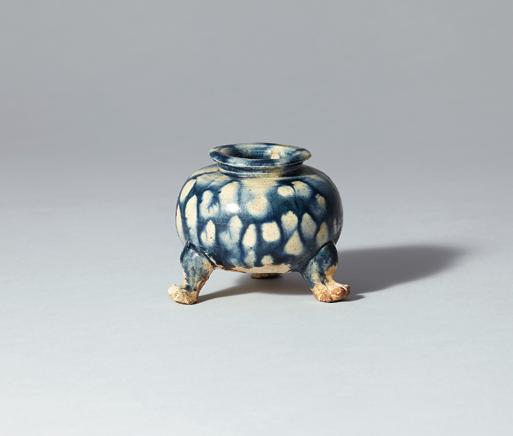
High Tang (7th - 8th centuries)
5.5 cm W. 7.0 cm
PROVENANCE
John Sparks, Ltd., London. Arthur M. Sackler (1913-1987) Collection. Else Sackler (1913-2000) Collection.
EXHIBITED
3500 Years of Chinese Art: Ceramics from the Arthur M. Sackler Collections, Israel Museum, Jerusalem, 1987.
133 61. 藍 ふく 彩 盛唐(7〜8世紀) 高5.5 cm 幅7.0 cm 来歴 John
Arthur
Else
出展 「3500
H.
Giaquili
AND COVER WITH BLUE PIGMENT
High Tang (7th - 8th centuries)

4.5 cm Dia. 9.5 cm
PROVENANCE
Gian Francesco Giaquili Ferrini Collection.
134 62. 藍彩盒子 盛唐(7〜8世紀) 高4.5 cm 径9.5 cm 来歴 Gian Francesco
Ferrini旧蔵. BOX
H.
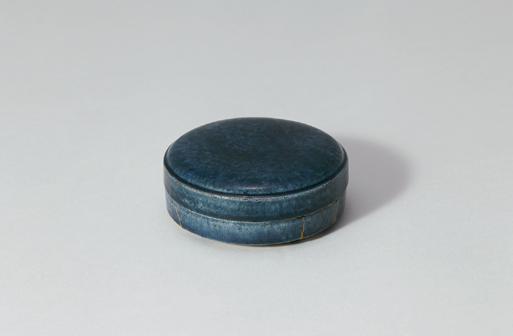
135 63. 藍釉盒子 盛唐(7〜8世紀) 高2.7 cm 径6.9 cm BLUE GLAZED BOX AND COVER High Tang (7th - 8th centuries) H. 2.7 cm Dia. 6.9 cm
64. 三彩盒子
盛唐(7〜8世紀) 高2.7 cm 径7.5 cm
壺中居.
SANCAI BOX AND COVER
High Tang (7th - 8th centuries) H. 2.7 cm Dia. 7.5 cm
PROVENANCE Kochukyo, Tokyo.
136
来歴

137
65. 藍彩碗
盛唐(7〜8世紀)
高4.6 cm 口径10.6 cm
Kate Sturges Buckingham(1858〜1937年)旧蔵. The Art Institute of Chicagoに寄贈, シカゴ, 1924年.
BOWL WITH BLUE PIGMENT
High Tang (7th - 8th centuries)
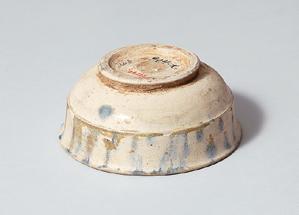
H. 4.6 cm Mouth Dia. 10.6 cm
PROVENANCE
Kate Sturges Buckingham (1858-1937) Collection. Gift to the Art Institute of Chicago, 1924.
138
来歴
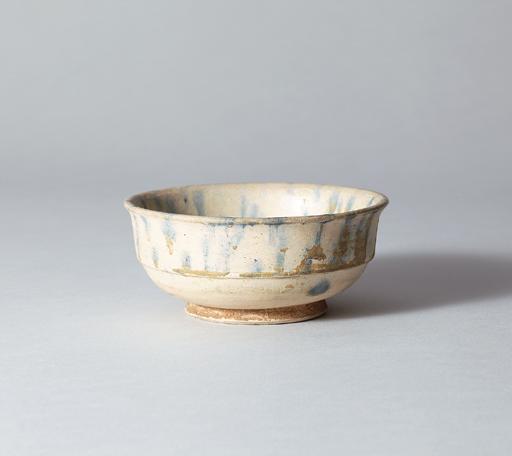
139
高3.3 cm 径5.7 cm
SANCAI BOX AND COVER High Tang (8th century) H. 3.3 cm Dia. 5.7 cm

140 66. 三彩盒子 盛唐(8世紀)
JAR WITH HANDLE

141 67. 三彩把手壺 盛唐(8世紀) 高6.5 cm 胴径6.0 cm 来歴 小林一三(1873〜1957年)旧蔵. SANCAI
High Tang (8th century) H. 6.5 cm Torso Dia. 6.0 cm PROVENANCE Kobayashi Ichizō (1873-1957) Collection.
68. 三彩華盤
盛唐(8世紀)
高5.1cm 幅17.4 cm
Russell M. Tyson(1867〜1963年)旧蔵.
The Art Institute of Chicagoに寄贈, シカゴ, 1951年.
SANCAI FOLIATE TRAY
High Tang (8th century) H. 5.1 cm W. 17.4 cm
PROVENANCE
Russell M. Tyson (1867-1963) Collection. Gift to the Art Institute of Chicago, 1951.
142
来歴
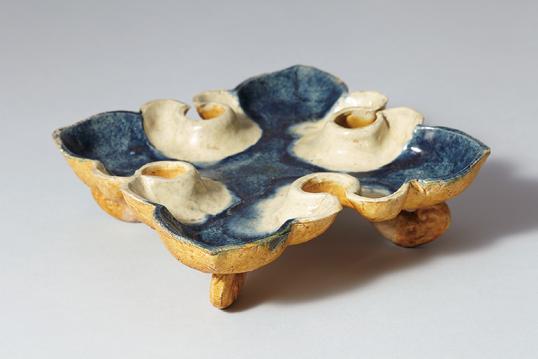
143
どのミニチュアは、玩具類あるいは装飾のための置物類に含めることができ るかもしれない。墓誌を伴った子どもの墓は極めて稀だが、河南沁陽の唐天宝

145 唐代(618 907 年)の鉛釉陶器として、いわゆる唐三彩が最も広く知られて いる。造形によって分類するならば、唐三彩は大きく俑類、建築模型類、器皿 類に分けることができる。そのうち、人物、馬、駱駝、鎮墓獣などの俑類や、 家屋、築山、棚などの広い意味での模型類は、主に墓に入れて副葬に用いる明 器に含まれる。もちろん、わずかながら例外もあり、一概に論じることは難し い。そのなかでも、あどけない男女の童俑、コミカルな牛車、鞍を置いた馬な
十四年(755 年)墓は、わずか 5 歳で夭折した李洪鈞が埋葬されており、三足鍑 (高 3 8㎝)、緑釉水注(高 6 5㎝)などのミニチュアが出土している 1。目下確認 されている小型三彩陶の中でも、この度の『唐三彩』展に出品されている環状 把手杯(図版 17)、弁口水注(図版 22)、四耳貼花小壺(図版 23)、三足鍑(図版 59、60、61)などのミニチュアは、もしかしたら児童用の玩具に属するもので、 子どもの墓に明器として副葬されたものかもしれない。しかしながら、目下の 考古資料を見る限り、大型製品を含む唐三彩の器皿類は、おそらくすべてが副 葬用の明器であったというわけではなく、人々が使用するための什器であった 可能性も考えられる。 1. 初唐の三彩 唐三彩の器皿類について検討するためには、まず器皿類が唐三彩の中で最も 早く出現したグループであることに留意する必要がある。これまでに発見され た、副葬に用いる明器の俑類の早い考古遺物の例としては、洛陽の則天武后期 垂拱三年(687 年)王雄誕夫人魏氏墓まで遡ることができる 2。これより早い時 代の出土例として、陝西省の上元二年(675 年)李 りほう 鳳墓出土の彩 さいとう 榻[寝台の意味] (挿図 1) 3 があり、検討の余地が残っているが、これ以外の唐高宗期(650 683 年)の三彩陶は、いずれも広い意味で器皿類に含まれている。水野清一氏はか つて唐詩の 4 分期になぞらえ、唐三彩を初唐(618 684 年)、盛唐(684 756 年)、 中唐(756 827 年)、晩唐(827 907 年)に区分している 4。この分期に従うと、 唐三彩雑感 謝 明良 挿図1 三彩榻 中国陝西省献陵 唐上元二年(675)李鳳墓出土 長さ25cm
たものだと考えられる。河南鞏義窯の区域を跨いだ広大な流通範囲は、非常に 驚くべきものがある。
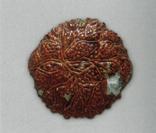
唐三彩の酒杯の器形は多様で、著名な杯のタイプとしては、李白(701 762 年)が『襄陽歌』に詠んだ「鸚鵡杯」が思いつく。鸚鵡の頭部は写実的で、腹 部は杯の形をしており、頭が腹部を向いている。また、首を体に向けた川鵜の 姿を模した鵜首角杯や、龍首角杯、さらには巻貝を半分に切ったような三彩螺 杯もある。後者の造形は法螺貝を模したもので、文献の記載によると、法螺貝

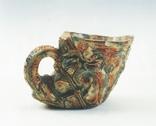
の殼の尾部の尖った箇所には段ができており、一つの空間が貫通しているだけ なので、酒器として用いると一気に飲み干すことができず、宴会などで罰杯と して用いるのに最適であった。そのほかにも、祖型が西方のリュトン(Rhyton) と関連する杯のタイプもあり、各種の獣首角杯のほかにも、長い鼻を反らせて
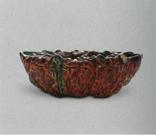
146 現在までに確認されている初唐の三彩は、ほぼすべてが器皿類に含まれる。 正式な発掘により初唐の墓葬から出土した三彩器には、型で成形された印花 の杯が比較的多く見られる。山東省陵県の咸亨二年(671 年)東方合夫婦墓 5 や、 遼寧省朝陽の咸亨三年(672 年)勾龍墓から出土した印花杯(挿図 2) 6、そして 今回の『唐三彩』展に出品されている 12 弁の菱形杯(図版 10)、半円形の杯(図 版 11、12、13)など、印花で成形された杯のスタイルは、いずれも西方の金銀 器を模倣している。後者は、日本の三重県 縄 なお 生 廃 はいじ 寺 遺跡の塔基で発見された、 舎利容器の上部を覆っていた唐三彩印花杯とよく似ている。上原真人氏が廃寺 遺跡出土の瓦をもとに作った編年を見ると、縄生廃寺はおよそ 7 世紀末から遅 くとも 8 世紀初期までに建立されており 7、舎利を安置する空間に置かれてい た三彩杯の年代は、当然それよりも早いと見るべきである。さらには、河南省 鞏 きょうぎこうや 義黄冶窯跡からこのタイプの印花杯を造るための陶器製の型が見つかってい ることから、7 世紀中後期に流行した三彩印花杯の多くは、鞏義窯で生産され
環状にした、耳付きの印花象首杯ないしは獣首杯がある。西安唐墓(挿図 3) 8 、 洛陽唐墓 9、湖北省鄖県の嗣聖元年(684 年)李徽墓などでも、このタイプの三 彩獣首杯と角杯(挿図 4)が出土している 10。これ以外には、下に承盤が付属す る多子杯もあり、例えば洛陽咸亨元年(670 年)張文惧墓からの出土例が確認で 挿図2 印花杯 中国遼寧省朝陽市咸亨三年(672)勾龍墓出土 直径12cm 挿図3 三彩象首杯 中国陝西省西安南郊唐墓出土 高さ7cm 挿図4 中国湖北省嗣聖元年(684) 李徽墓出土唐三彩(実測図)
く用いられた技法であったと判断できる。『唐三彩』展に出品されている梅瓶(図 版 3)や、二段の燭台(図版 4)もまた、その一例である。前者の梅瓶は、中国
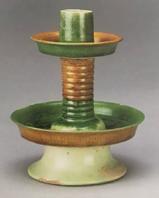


147 き(挿図 5)、今回の『唐三彩』展でも類品(図版 21)が出品されている。承盤 内に置く小杯の数は決まっていないが、それらが取り囲む盤の中央には、高足 盤や口がすぼんだ盂などが置かれることもあり、いくつかのバリエーションが 確認されている。このタイプの多子盤は盤の中心に一つの杯(あるいは盂など) を置き、その周囲に六つの小さい杯を置くことが多いため、「七星盤」という 名称で呼ばれることがある。なお、杯の数が少ない場合や、あるいは 7 個以上 が置かれた唐代の多子杯盤であっても、この名称が用いられる。 以上のように、現在までに発見された考古資料から判断すると、初唐(618 684 年)の三彩器はみな広い意味での器皿類に含まれ、専ら副葬に用いる陶俑 などの明器は今のところ確認されていない。このため、唐三彩の出現は唐代の 人々が厚葬を好んだために起こったというよく聞く学説は、考古出土状況と合 致しないのである。 陝西省で見つかった上元二年(675 年)の李鳳墓出土の三彩榻(前掲挿図 1)や 三彩瓢形有足盤、さらにはその他の初唐の三彩器の施釉技法を見ると、線描あ るいは点を繋げて線を表す方法によって、緑色や褐色の釉を素地の上に施して いる。このように、鉛釉が流れる効果を活かした施釉方法は、初唐の三彩でよ
での出現時期が北朝まで遡る器物で、陝西省の隋大業四年(608 年)李静訓墓か らは、墨緑ガラスの小梅瓶(挿図 6)が出土している。二段の燭台は隋唐期の響 銅など金属器によく見られ、河南省鞏義市の芝田二電廠唐墓(M4)からも、こ のタイプの三彩燭台(挿図 7)が確認されている。 2. 唐三彩器皿類の用途 高火度焼成で造られる堅牢な炻器と比べて、陶胎上に鉛釉を施して低火度焼 成を行う唐三彩などの鉛釉陶は、どうしても柔らかく粗製になってしまう。一 部の器皿類は、高火度で素焼した後に釉をかけ、低火度で二次焼成を行ってい るとはいえ、やはり液体を入れるのには向いていない。さらには鉛釉陶器を使 用することで、慢性的な鉛中毒を引き起こし、ひどい場合には死に至ると認識 されていたという説も聞く。もっとも、鉛の毒性は近代における公衆衛生の発 展によって明らかになったことであり、鉛や水銀などが有毒金属だという現代 人の考え方を、それらが不老長寿の仙薬の材料だと信じていた古代中国の人々 に当てはめることはできない。 一方で学術界においては、墓葬以外の遺跡からも唐三彩が出土することが、 挿図5 三彩杯と承盤 中国河南省洛陽市咸亨元年(670)張文倶墓出土 直径25cm 挿図6 墨緑ガラス梅瓶 中国陝西省隋大興四年(608)李静訓墓出土 高さ16cm 挿図7 三彩燭台 中国河南省鞏義市芝田二電廠唐墓(M4)出土 高さ24cm
唐三彩の器皿に仏教儀物が含まれていたかを証明することは困難だが、以下 にいくつかの寺院遺跡から出土した唐三彩の資料を列挙することで、唐三彩が 仏僧たちに受容されていたのかについて簡単に示したい。例えば、陝西省臨潼
慶山寺の舎利塔の下で見つかった釈迦如来舎利精室には、石門の両側に護法の ための三彩獅子(挿図 9)が 2 匹安置されていただけでなく、石製の舎利宝帳の 前方には、1 列に並んだ三彩供盤が 3 件置かれていた。真ん中の盤には三彩の 南瓜(挿図 10)が供えられており、その他の

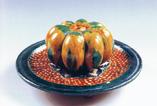

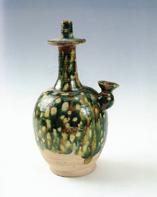
148 徐々に認識されるようになってきた。出土する唐三彩の器形は、玩具とおぼ しき小型俑像や仏像(羅漢)の破片等を除き、圧倒的多数は器皿類に属してい る 11。この状況は、唐三彩の器皿類のある一群が、実用器物として供されてい た可能性を実証している。このため、本稿では唐三彩の器皿類を観察すること で、いったいどのように「実用」されていたのかを検討し、それらが消費され た文脈を整理してみたい。 唐三彩の製品には、まれに浄瓶(挿図 8)などの仏教用具に関する器種が確認 できるうえ 12、仏教遺跡からも少なからず唐三彩が出土している。筆者はこの 類の三彩浄瓶が確実に仏僧によって使用されていたのか、あるいは陶工が寺院 の金属器などの象徴的な器物を模して作ったのか、実証することはできない。 しかしながら、唐三彩の器皿類と仏教儀物との間には、興味深い関連性がある。
2 件の盤には、それぞれガラス製 の供物が数件ほど置かれていた。共伴した「上方舍利塔記」の石碑には、下の 方に「翰林内供奉僧貞干詞兼書」銘と「大唐開元廿九年(741 年)四月八日」の 紀年銘が彫られていた 13。他の例として、唐長安城太平坊実際寺遺跡からは、 口径が 30㎝にもなる折沿盆(挿図 11)が出土し 14、陝西華陽西岳廟遺跡からは、 装飾が極めて美しい蓋付きの三彩盒子が見つかっている 15。江蘇省揚州では、 日本からの留学僧であった円仁が仏法を求めて入唐した際に住んだ龍興寺の遺 跡からも、三彩の資料が出土している 16。さらに、唐長安城新昌坊東南に位置 する密教の中心的寺院であった青龍寺からは、念珠を手に携えた三彩羅漢像(挿 図 12)が出土している 17。同じ造形の三彩羅漢の残欠(挿図 13)は、陝西省西安 の旧飛行場で、かつての長安城醴 れいせんぼう 泉坊内に比定される地点からも出土している。 近くには三彩窯跡が見つかっていることから、羅漢像はこの窯で焼造された製 品であったと推定されている 18 。 西安旧飛行場の三彩窯跡は、唐代には長安城醴泉坊に位置しており、窯場は 挿図8 三彩浄瓶 中国陝西省西安三橋鎮出土 高さ26cm 挿図9 三彩獅子 中国陜西省臨潼慶山寺塔基出土 高さ18cm 挿図10 三彩南瓜 中国陜西省臨潼慶山寺塔基出土 南瓜:直径 14cm 盤:直径24cm 挿図11 三彩折沿盆 中国陝西省唐長安城太平坊実際寺遺跡出土 直径30cm
14)は、専ら寺院のために焼造した物であった




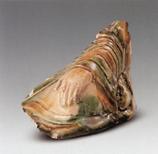
造した窯場が見つかっている。この窯の位置は、唐代前後には白馬寺の領域で
年)に比定

149 挿図12 三彩羅漢残部 中国陝西省西安唐青龍寺遺跡出土 高さ4cm 挿図14 三彩磚 唐長安醴泉坊窯跡出土 挿図15 三彩枕の実測図 中国江西省瑞昌県唐墓出土 左:高さ5cm 右:直径20cm 長さ11cm 街道を隔てて醴泉寺と隣接していたため、報告書ではその窯が寺院に関連して いたと判断し、醴泉寺窯と名付けている。確かに、この窯跡で見られる三彩 羅漢像や宝相華文の磚(挿図
19 。 この他にも、河南省洛陽の白馬寺からも、唐三彩の盆、盂、豆など器皿類を焼
あり、その北側で唐代に修建された寺院の遺跡も発見された。報告書ではさら に関連する文献史料を対照させ、窯の創業時期を武周垂拱初年(685
している。くわえて、薛 せつかいぎ 懐義が白馬寺の住持であった時に、白馬寺が勅命で修 建されたことと密接に関わっていたと判断し、この窯が「官窯」であったと述 べた上で、共伴した三彩資料はおそらく白馬寺院で使用した器物であったと指 摘している 20。上述の西安醴泉坊窯と洛陽白馬寺窯の 2 箇所の三彩窯場は、寺 院に所属するものであったのか、あるいは寺院と関連があったのか、証明する ことは難しい。しかし、醴泉坊窯で焼造された三彩羅漢像が寺院で使用されて いたこと自体は、考古発掘によってすでに実証されたと言えるだろう。 寺院遺跡から出土した唐三彩資料について、個々の三彩窯場が寺院によって 運営されていた可能性を考える以外に、1980 年代に江西省瑞昌県で唐三彩枕 形器が出土した遺跡は、報告書によって「僧人墓」であると比定されており、 注目に値する。この瑞昌県范鎮郷朱家村唐墓は、墓室が完全に破壊されており、 形状も不明であったが、三彩枕形器(報告書では「脈枕」と書かれている)(挿 図 15)の他にも、青銅鍍金塔式頂盒子、青銅鍍金瓶鎮柄香炉、青銅鉢が共伴し ていたようである 21。近年の調査によって明らかになったが、仏具として造ら れたであろうこの瓶鎮柄香炉は、実際には范鎮八都村の畑から出土しており、 挿図13 三彩羅漢残部 唐長安醴泉坊窯跡出土 高さ7cm
范鎮朱家村から出土した三彩枕形器とは全く関係が無かった 22。しかし青銅鍍 金盒子と青銅鉢は、確かに三彩枕形器と共に出土しており、日本の正倉院に収 蔵されている内部に香などを入れた高足銅盒子とも類似している 23。さらには、 洛陽永泰元年(765 年)荷澤神会身塔の塔基から共に出土した銅盒と手炉の組み 合わせを想起させる 24。ここから、瑞昌范鎮朱家村の盒子は、本来は手炉と組 み合わせて使用する仏具であった可能性があり、これによりその墓主が仏僧で

彩枕形器は、仏教に関連した什器であった可能性が高い。
『唐三彩』展には、器形が異なる多くの枕形器ないしは磚形器が出品されて いる(図版 26、27、28、29、30、31)。だが、この類の作例が本当に枕であっ たのかという問題が存在し、学術界でも意見が分かれている。先行研究を見る と、その用途として頭枕、脈枕、書枕、頸枕、明器枕、および台座、文鎮など の諸説が提示されている。日本の奈良県の大安寺講堂遺跡から出土した、復元 すると約 30 〜 40 個体になる三彩枕形器を見ると、このタイプの作品が仏教に 関わる什器であった可能性が高いように思える 25。またこの用途に関する事例 として、陝西省銅川新区西安変電廠一号墓(M1)は未盗掘墓であり、ここから 出土した三彩枕は、墓主の頭骨の下に置かれていた(挿図 16)26。その墓の年代 は遅くとも中唐期(756 827 年)であり、盛唐期の三彩枕形器が、頭の下に置く 枕として使われていた可能性を考える上での重要な事例となる 27 。
150
あった可能性が高まった。以上のように、青銅盒子などの仏具と共出した唐三
挿図16 図中の8は三彩枕、9は「開元通宝」(口に含む) 中国陝西省銅川新区西安変電廠一号墓 平面図
墓獣」という俗称で呼ばれるが、実はこれは近代の人が命名し



年代に河南省鞏義唐墓から出土した、

151 3. 陶俑および明器としての模型 7 世紀後期から 8 世紀中期、すなわち則天武后の大周年間か ら、玄宗皇帝の開元〜天宝年間は、唐朝が最も繁栄した時代で あり、唐三彩の副葬用陶俑の生産が始まり、発展のピークを迎 えた段階に当たる。この時期には唐三彩陶が共伴する墓葬の例 が極めて多く、河南省洛陽と陝西省西安の唐代両都が置かれて いた地区に集中している。本章では、未盗掘で発見されたため に保存状態が良好で、なおかつ墓主の身分と埋葬年代が明らか な洛陽孟津西山頭唐墓(M64)出土の唐三彩を例に見ていきた い 28。この墓の墓主である屈 くっとつきさつ 突季札は、銀青光禄大夫燕郡公で あった屈突詮の子であり、天授二年(691 年)に洛陽 北 ほくぼうざん 邙山 に埋 葬された。出土した三彩陶は、鎮墓獣、天王俑、文武官俑、騎 馬俑、男女立俑、動物俑などを含んでおり、そのうちの三彩鎮 墓獣(挿図 17a)、男騎俑(挿図 17b)、三彩犬(挿図 17c)の造形は、 『唐三彩』展の出展作品(図版 38、40、43)を見る上での参考資 料となる。河南洛陽の景龍三年(709 年)安国人定遠将軍安菩夫 婦墓から出土した三彩女俑(挿図 18)は、髪形と衣服のスタイ ルが今回出品されている女俑(図版 45)のそれとよく似ている。 単角人面と双角獣面の 2 件が 1 組で組み合わされる俑は、「鎮
た呼称である。1980
1 件 の双角獣面陶製鎮墓獣の背中には、墨書で「祖明」という字が 書かれていた(挿図 19 a、b)29。唐開元二十七年(739 年)の『唐 六典』によれば、副葬品として墓に入れる類の「四神」には、「当 壙、当野、祖明、地軸」があると記載されていることから、こ の獣面鎮墓獣は四神の一つである「祖明」であったと考えられ る。 前述した通り、これまでに確認されている副葬品として墓に 入れられた三彩陶俑は、最も早い例が洛陽垂拱三年(687 年)王 雄誕夫人魏氏墓である。そして、今回の『唐三彩』展に出品さ れた南海地域(唐代には 崑 こんろん 崙 と呼ばれた)の人を象った三彩俑 (図版 9)は、大英博物館にも類品がある他、その造形が陝西禮 泉麟徳元年(664 年)右武衛大将軍鄭 ていじんたい 仁泰墓から出土した灰陶加 彩俑とおおむね一致している(挿図 20)30。鄭仁泰墓は盗掘に 挿図17a 三彩鎮墓獣 左:通高62.5cm 右:通高69cm 中国河南省洛陽天授二年(691) 屈突季札墓出土 挿図17b 三彩男騎馬俑 通高39cm 中国河南省洛陽天授二年(691) 屈突季札墓出土 挿図17c 三彩犬俑 高さ14.4cm 中国河南省洛陽天授二年 (691)屈突季札墓出土 挿図18 三彩女俑 中国河南省洛陽景龍三年(709) 安菩夫婦墓出土 高さ33cm
あっているが、墓中には白地コバルト藍彩蓋鈕の破片(挿図 21)が 1 件残され ており、唐三彩鉛釉陶の器皿類の最も早い製作年代は、660 年代まで遡る可能 性が考えられる。くわえて、造型が良く似ている鄭仁泰墓灰陶加彩俑と前述の 三彩南海人物俑の製作された年代も注目に値する。二つの俑が似ている要因と して、同一類型の陶俑を成形する「型」が長い期間にわたって使用されたため、 三彩俑の副葬が流行した

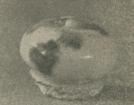
7 世紀後期においても、数十年前のスタイルの俑や像 が造られたのか。あるいは、7 世紀中期にすでに三彩釉を施した俑や像が造ら れていたのか。さらに深く検討する必要があるだろう。
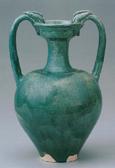

ここで一度、鄭仁泰墓出土の藍彩を施した蓋の鈕について見てみたい。良く 知られたことではあるが、この藍彩は中国陶磁史上初めてコバルト藍釉を用い て加飾した事例である。かつて行われた唐代鉛釉陶藍彩の化学分析によると、 そのコバルト顔料は鉄分が多く、マンガンが少ないことが明らかにされている。 中国産のコバルト顔料は、マンガンが多く鉄が少ないため、この藍彩には輸入 顔料を使用していたと考えられ

152
31、外来のコバルト藍ガラスを加工していた可 能性もある。コバルト藍彩を帯びた唐代鉛釉陶器は、多くが凝った作りになっ ており、レベルも比較的高く、それは今回の『唐三彩』展の作品からも感じる ことができる。なお、最も有名な考古出土例としては、唐垂拱三年(687 年)に 副葬された河南恭陵の太子妃 裴 はい 氏(諡号は哀皇后という)墓から出土した、コ バルト藍釉双龍耳瓶(挿図 22)等の作品を挙げることができる 32 。 『唐三彩』展には、藍彩を施した作品も多く出品されており、前掲の小型の 鍑(図版 59、60、61)の他、盒子(図版 62、63)、洗(図版 58)、印花の連珠平 盤(図版 52)、碗(図版 65)、4 弁の輪花盤(図版 68)、双耳壺(図版 16)がある。 後者の壺はいわゆる「万年壺」のスタイルであり、この類の器物にはもともと 挿図19a 陶鎮墓獣 中国河南省鞏義市唐墓出土 高さ30cm 挿図19b 図19aの背面「祖明」墨書 挿図20 中国陝西省昭陵麟徳元(664) 鄭仁泰墓出土 高さ30cm 挿図21 藍彩蓋鈕 中国陝西省昭陵麟徳元年(664)鄭仁泰墓出土 高さ3cm 挿図22 濃緑釉龍耳瓶 唐垂拱三年(687) 中国河南省偃師市恭陵哀皇后墓出土 高さ32.2cm 洛陽博物館蔵
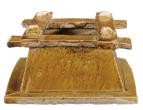
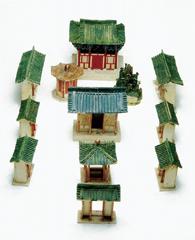
153 蓋が添っており、前述した鄭仁泰墓の藍彩鈕(前掲挿図 21)が、まさに このような器物に乗せる蓋の鈕部分であった。このほか、出品された 胡服童子(図版 46)の衣服には、黄褐釉と藍釉が施されている。その姿 勢は、よく見られる駱駝を引く胡人馭駝俑と共通している。『唐三彩』 展に出品された明器の模型にもまた、藍釉を施したタイプがあり、四 方の舂杵(図版 34)や井戸(図版 35)を挙げることができる。唐墓では、 このように陶製の井戸と舂碓を副葬することが度々見られる。例えば、 前述の洛陽孟津天授二年(691 年)屈突季札墓では、陶製の井戸、舂碓、 かまど等が見つかっており、洛陽景龍三年(708 年)宣州宣城令李敬彝 墓からは、黄褐釉を施した陶製の井戸が出土している(挿図 23)33。偃 師県長寿三年(693 年)張思忠墓からは、三彩陶の舂碓と井戸が共伴し ている他、同時に盤中央に 1 件の白磁杯を置き、その周囲に 8 件の三 彩小杯を並べた多子盤も確認されている 34 。 三彩家屋の例はやや少ないが、陝西省銅川あるいは西安中堡村唐墓 から出土した三彩邸宅模型は、良く知られた名品である。邸宅建築模 型は、大門、房舎、亭、築山、および井戸、磨臼、人、馬等を含んでおり、 唐代邸宅の建築と生活空間の構造を反映している(挿図 24)。その中で も、中堡村唐墓から出土した懸山式の方形屋根の建物は、中央の扉が 開き、扉の両側には格子窓が付き、屋根はコバルト藍釉が施されてい る。家屋全体は彩色され 35、建築様式は『唐三彩』展の緑褐釉家屋(図 版 32)とよく似ている。ほかにも、出品されている藍褐釉倉(図版 33) もまた、盛唐期の北方で見られた糧倉の様式を模している。倉には扉 がなく、わずかに倉の一面の高い所に、通風口を兼ねた方形の窓が開 いており、これもまた唐代の木造倉の特徴を忠実に模倣しているので ある。 (しゃ めいりょう/國立台灣大學 藝術史研究所 講座教授) 挿図23 中国河南省洛陽景龍三年(708) 李敬彝墓出土褐釉井欄 長さ13.4cm 挿図24 三彩建築群 中国陝西省西安市西郊中堡村唐墓出土
の年代をもとに判断している、ただ山田寺は奈良時代に補修した時にも、 同じ「型」を用いて製造していた。そのうえ、山原寺式瓦は 8 世紀に下る 例も確認されている。このため、縄生廃寺の年代は必ずしも 7 世紀とは言 いきれない」と指摘している(同氏「奈良三彩の起源と唐三彩─技術 / 意 匠の系譜について」『美術フォーラム 21』4, 2001 年, p. 55)。いずれにせよ、 三彩印花杯のスタイルなどを見ると、その相対的な年代は 7 世紀後期だと 考えられる。あるいは、亀井明徳教授が主張したように、
154 註 1 李志軍等「河南沁陽唐代李洪鈞墓発掘簡報」『洛陽考古』2015 年 1 期 , pp. 30 〜 34 2 洛陽市文物考古研究院(陳誼等)「洛陽唐代王雄誕夫人魏氏墓発掘簡報」『華 夏考古』2018 年 3 期 , pp. 15 〜 29 洛陽市文物考古研究院編『唐・王雄誕夫 人魏氏墓』鄭州:中州古籍出版社 , 2016 年. 3 富平県文化館等「唐李鳳墓発掘簡報」『考古』1977 年 5 期 , pp. 313 〜 326 4 水野清一『唐三彩』陶器全集 25, 東京:平凡社 , 1965 年, pp. 8 〜 9 5 亀井明徳「日本出土唐代鉛釉陶の研究」『日本考古学』第 16 号, 2003 年, p. 153,『人民網』2002 年 3 月 21 日より引用 魏訓田「山東陵県出土唐《東 方合墓誌》考釈」『文献』2004 年 3 期 , pp. 89 〜 97 を参照。カラー図版 は、柴晶晶編「“東方朔係陵県人”的有利佐証」を参照。http://www. dezhoudaily.com/news/dezhou/folder136/2012/11/2012 11 04400444.html (閲覧日:2013 年 7 月 25 日) . 6. 朝陽市博物館(李国学等)「朝陽市郊唐墓清理簡報」『遼海文物学刊』1987 年 1 期 , 図版 2 2. 7. 上原真人「縄生廃寺の舍利容器」『仏教芸術』188 号, 1990 年, p. 119 〜 131. このほか、尾野善裕氏は、「縄生廃寺の年代は、山田寺式と山原寺式の瓦
7 世紀第 3 四半 期の可能性もある(亀井明徳「陶範成形による隋唐の陶瓷器」『出光美術館 館報』106, 1999 年, p. 84)。 8 陳安利主編『中華国宝:陝西珍貴文物集成』第 2 冊・唐三彩巻 , 西安:陝 西人民教育出版社 , 1988 年, pp. 20 〜 21 9 洛陽市博物館編『洛陽唐三彩』北京:文物出版社 , 1980 年, 図 114 10. 湖北省博物館(全錦雲等)「湖北鄖県唐李徽・閻婉墓発掘簡報」『文物』1987 年 8 期 , p. 32, 図 2 8, 11, 13, 14, および図版 4 2 〜 4 関連する先行研究とし ては、孫機「瑪瑙獣首杯」(同氏著『中国聖火─中国古文物与東亜文化交 流中的若干問題』瀋陽:遼寧教育出版社 , 1996 年, pp. 178 〜 197 所収)を参 照。 11 謝明良「唐三彩の諸問題」(成城大学)『美学美術史論集』5, 1985 年, pp. 178 〜 179,「表一:墓葬以外遺跡出土唐三彩」
155 12. 前掲註 8, 陳安利主編『中華国宝:陝西珍貴文物集成』第 2 冊・唐三彩巻 , pp. 80 〜 81. 13. 臨潼県博物館(趙康民)「臨潼慶山寺舍利塔基精室清理記」『文博』1985 年 5 期 , p. 13, および図 4 3, 4. 14. 劉瑞「西北大学出土唐代文物」『考古与文物』1999 年 6 期 , 裏表紙の図版 . 西北大学文博学院『百年学府聚珍:西北大学歴史博物館蔵品選』北京:文 物出版社 , 2002 年, 図 138. 実際寺の歴史沿革とその他の出土文物について は、柏明主編『唐長安城太平坊与実際寺』(西安:西北大学, 1994 年)を参 照のこと。 15 「陝西華陽岳廟遺址」(国家文物局『1998 中国重要考古発現』(北京:文物 出版社 , 2000 年, pp. 81 〜 83 所収) 16 南京博物院(羅宗真)「揚州唐代寺廟遺址的発現和発掘」『文物』1980 年 3 期 , p. 31 17 中国社会科学院考古研究所西安工作隊「唐青龍寺遺址発掘簡報」『考古』 1974 年 5 期 , p. 306, 図版 12 4 18 小林仁「西安・唐代醴泉坊窯址の発掘成果とその意義―俑を中心とした考 察」『民族藝術』21 号, 2005 年, pp. 118 〜 119 19 陜西省考古研究院『唐長安醴泉坊三彩窯址』北京:文物出版社 , 2008 年, p. 9 20. 中国社会科学院考古研究所洛陽漢魏故城隊(銭国祥等)「河南洛陽市白馬寺 唐代窯址発掘簡報」『考古』2005 年 3 期 , pp. 45 〜 54 21. 何国良「江西瑞昌唐代僧人墓」『南方文物』1999 年 2 期 , pp. 8 〜 10. 22. 加島勝「柄香炉と水瓶」『日本の美術』540 号, 東京:至文堂 , 2011 年, p. 46. 23. 毛利光俊彥『古代東アジアの金属製容器』Ⅰ(中国編)奈良文化財研究所 , 2004 年, p. 73. 24. 洛陽市文物工作隊(余扶危等)「洛陽唐神会和尚身塔塔基清理」『文物』1992 年 3 期 , pp. 64 〜 67, 75. 25. 日本出土の唐三彩枕形器に関する諸説については、以下の文献を参照のこ と。謝明良「日本出土唐三彩及其有関問題」『中国古代貿易瓷国際学術研 討会論文集』(1994 年)初出。後に、『貿易陶瓷与文化史』(北京:三聯書店 , 2019 年, pp. 3 〜 27)に採録。亀井明徳「三彩陶枕と筺形器の形式と用途」, 同氏著『中国陶瓷史の研究』(東京:六一書房 , 2014 年, pp. 221 〜 241)所収。 26 銅川市考古研究所(董彩琪)「陝西銅川新区西南変電站唐墓発掘簡報」『考古 与文物』2019 年 1 期 , pp. 37 〜 45
156 27. 詳しくは、謝明良「再談唐代鉛釉陶枕」『故宮文物月刊』437 期 , 2019 年初 出 ,『陶瓷手記 4:区域之間的交流和影響』(上海:上海書画出版社 , 2021 年, pp. 27 〜 39)再録。 28. 301 国道孟津考古隊(王炬等)「洛陽孟津西山頭唐墓発掘報告」『華夏考古』 1993 年 1 期 , pp. 52 〜 68. 29. 張文霞等「隋唐時期的鎮墓神物」『中原文物』2003 年 6 期 , p. 69, 図 7. カラー 図版は, 鄭州市文物考古研究所『中国古代鎮墓神物』(北京:文物出版社 , 2004 年)図 161 を参照 30. 陝西省博物館等唐墓発掘組「唐鄭仁泰墓発掘簡報」『文物』1972 年 7 期 , 図 版 10 3 31. 陳尭成等「歴代青花瓷器和青花色料的研究」『硅酸塩学報』6 巻 4 期 , 1978 年, pp. 225 〜 241 「河南鞏県黄冶窯唐代藍彩器研究」(羅宏傑等編『古陶瓷 科学技術 7:国際討論会論文集』上海:上海科学技術文献出版社 , 2009 年, pp. 319 〜 328 所収) 32 朝日新聞社等編『唐三彩展 洛陽の夢』(大広 , 2004 年, p. 51, 図 21)等、多 数の書籍に収録 33 洛陽市文物考古研究院(司馬国紀)「洛陽市唐代李敬彝墓清理簡報」『華夏考 古』2019 年 3 期 , p. 36, 図 17 1 カラー図版は , 何娟等「大唐望族・三彩風 華 洛陽唐代李敬彝墓出土三彩器物浅述」(『典蔵』古美術 , 345 期 , 2021 年, p. 98)図 27 を参照 . 34 偃師県文物管理委員会(王竹林)「河南偃師県隋唐墓発掘簡報」『考古』1986 年 11 期 , p. 999, 図 8 6, 10, および図版 6 5. 35 前掲註 8, 陳安利主編『中華国宝:陝西珍貴文物集成』唐三彩巻 , p. 99
Miscellaneous Thoughts on Tang Sancai
Hsieh Ming-liang
Today Tang sancai , or tri-colored ware, is the best-known, lead-glazed ceramic ware of the Tang dynasty (618 907). In terms of vessel shape, Tang sancai can be largely divided into figurines, architectural models and dish ware. Of those, the figurines, whether people, horses, camels, tomb guardian mythical beasts, or object and architectural miniature models, from houses to mountain-like landscape miniatures and household furnishings, were primarily made as grave goods to be interred with the deceased. Of course, there were some rare exceptions of other uses, but they are not commonly found. Of those exceptions, we might consider that some of the miniatures, such as adorable boy or girl figurines, comical ox carts or saddled horses, may have been made as toys or decorative objects. Tombs for children with burial detail steles are extremely rare, but various miniatures, including a tripod fu (H. 3.8 cm) and a green-glazed ewer (H. 6.5 cm), have been excavated from a tomb built in Qinyang, Henan province, in 755 (Tang Tianbao 14) for Li Hongjun who died at the young age of 5 1 Among the confirmed miniature sancai ceramic types known today, the miniatures included in this Tang Sancai exhibition -- such as a cup with circular handle (pl. 17), a ewer with pinched spout (pl. 22), a small jar with four handles and applique designs (pl. 23) and the tripod fu (pls. 59, 60, 61) -- are all types that could have been toys for children, and as such, may have been grave goods for children's tombs. However, to the degree I have found in archeological materials, some Tang sancai dishware, including large works, may have been used as practi cal everyday goods, while others were burial goods.
1. Early Tang Sancai
In a consideration of Tang sancai dishware types, first we must keep in mind that dishware was the earliest vessel category that appeared in Tang sancai ware. At present the earliest excavated examples of figurines used as burial goods date back to the tomb of Wei, wife of Wang Xiongdan, buried in 687 (Chuigong 3)
157
Fig. 1
Sancai Platform Bed, excavated from the tomb of Li Feng (675, Tang Shang Yuan 2) Xian Mausoleum, Shanxi province, L. 25 cm.

in Luoyang during the reign of the female emperor Wu Zetian.2 An earlier ex cavated example can be seen in the painted sleeping platform (fig. 1) 3, excavated from the tomb of Li Feng, buried in 675 (Shangyuan 2) in Shanxi province. While there is some room for further examination, Tang Gaozong period (650 683) sancai wares, except for the sleeping platform, are all dishware in the broad sense of the term. Mizuno Seiichi has previously likened sancai periods to the four periods of Tang literature, namely Early Tang (618 684), High Tang (684 756), Mid Tang (756 827) and Late Tang (827 907)4. In line with that chronology, almost all confirmed Early Tang sancai examples are dishware.
Fig. 2 Cup with Impressed Floral Designs, excavated from the tomb of Gou Long (672, Xianheng 3), Zhaoyang city, Liaoning province, Dia. 12 cm.


A relatively large number of mold-formed cups with impressed designs can be seen in the sancai wares that have been properly excavated from Early Tang tombs. The cups with impressed designs (fig. 2) excavated from such tombs as those of Dong Fanghe and his wife dated 671 (Xianheng 2)5 in Ling district, Shandong province, or the Goulong tomb dated 672 (Xianheng 3)6 in Chaoyang, Liaoning province, or among the works exhibited here, the 12-petal, lozenge-shaped cup (pl. 10), and the semi-spherical cups (pls. 11, 12 , 13), are all examples of cups formed with impressed designs, and all imitate West Asian gold and silver wares. The semi-spherical cup closely resembles a Tang sancai im pressed design cup that was found on top of the reliquary buried at the base of the pagoda in the grounds of the Naohaiji temple ruins in Mie prefecture. Looking at the chronology Uehara Mahito created on the basis of the tiles excavated at Naohaiji sites, Naohaiji was probably established at the end of the 7th century or at the latest, the beginning of the 8th century7, and thus the sancai cup placed in the reliquary enshrining space should naturally be considered to predate that period. Given that molds for the production of this type of cup with impressed designs have been found at the Gongyi Huangye kiln site, Henan province, the majority of the sancai cups with impressed designs popular in the middle and late 7th century can be thought to have been made at the Gongyi kilns, and indeed, the broad distribution range of the objects made in that kiln district is truly impressive.
Tang sancai wine cup vessel shapes vary widely and remind us of the famous yingwu (鸚鵡杯, parrot cup) type heralded by Li Bai (701 762) in his Xiangyang Song (Xiangyang ge). In this cup type a realistically formed parrot's
158
Fig. 3
Sancai Elephant Head Rhyton, excavated from a Tang tomb in the southern suburbs of, Xi’an city, Shanxi province), H. 7 cm.
Fig. 4
Archaeological Drawing of a Tang Sancai Work, excavated from the tomb of Li Hui (684, Sisheng 1), Hubei province.
head is attached to the bird's body which constitutes the cup section, with the head turned back towards its body. There are also horn-shaped cups with cormorant neck forms turned back towards the cup body, or dragon-headed horn-shaped cups and sancai snail-shell cups that look like coiled shells cut in half. The latter was made to look like a conch shell. According to textual records the pointed protruding tail section of a conch shell cup had internal steps, and since only a single hollow space extended through the whole shell, a drinker cannot drain the cup in a single draught when such cups are used as a wine vessel. This made them the most appropriate vessel type for the cups used by those who lost bets at banquets and other such events. There were also cup shapes related to the West Asian rhyton form, horn-shaped cups with various types of animal head handles and cups with various beasts, such as the impressed design elephant head cups with their long trunks turned back into a circular form. These types of animal head cups and horn-shaped cups (fig. 4) have been excavated at various tombs, including the Xi ʼan Tang tombs (fig. 3)8, Luoyang Tang tombs,9 and Li Hui tomb dated 684 (Sisheng 1) in Yun district, Hubei province.10 Other than these types there are also examples of sets of cups with accompanying trays, such as the example (fig. 5) excavated from the Zhang Wenju tomb dated 670 (Xianheng 1) in Luoyang and a similar example (pl. 21) exhibited here. A range of variations have been confirmed for such sets, with no set number of little cups placed on the trays. Often a tall footed tray (高足盤) or round jar with a small mouth (盂) is placed in the center of the tray. This type of cup and tray set in which a single cup or yu was placed in the center of the tray and then surrounded by six smaller cups, came to be known as "seven star trays" (qi xing pan 七星盤). Even if the number

Fig. 5
Sancai Tray and Cups Set, excavated from the tomb of Zhang Wenju (670, Xianheng 1), Luoyang city, Henan province, Tray dia. 25 cm.


159
Fig. 6
Blackish Green Glass Meiping Jar, excavated from the tomb of Li Jingxun (608, Sui Daxing 4), Shanxi province, H. 16 cm.

of surrounding cups was actually more or less than six, this was the name used for these cup and tray sets.

As seen above, judging from the currently excavated materials, the sancai wares from the Early Tang (618 684) were dishware in the broad sense of the term, and at present there are no known examples of works, such as figurines, specifically made as grave goods from that time period. This indicates that the frequently heard scholarly theory that Tang sancai wares appeared because of the Tang preference for elaborate funerary practices does not accord with the state of archaeological excavation evidence.
If we look at the glazing techniques used on the sancai platform bed excavated from the 675 tomb discussed above as fig. 1, a footed gourd-shaped tray, and other Early Tang sancai , we notice that drawn lines or continuous lines of dots of green and amber glaze were applied directly to the unglazed clay surface. This indicates that the glazing method which completely activated the flowing effect inherent in lead glaze was fully used in Early Tang sancai . Two works in this Tang Sancai exhibition, the meiping jar pl. 3 and the two-tier lamp pl. 4, are also examples of this fact. The meiping jar is a vessel type which appeared in China from the Northern Dynasties onwards. A small blackish green glass meiping jar (fig. 6) was excavated from the Li Jingxun tomb dated 608 (Sui Daye 4) in Shanxi province. The two-tier lamp is a shape often found in Sui and Tang copper-alloy (響銅) wares, and a sancai example (fig. 7) of this type can be confirmed from the Zhitian Erdianchang Tang Tombs (M4) (芝田二電廠唐墓) in Gongyi city, Henan province.
2. How Tang Sancai Dishware Was Used
Fig. 7
Sancai Lamp, excavated from Zhitian Erdianchang Tang Tomb (M4), Gongyi city, Henan province, H. 24 cm.
Compared to strong, high-fired stoneware, iron-glazed pottery such as Tang sancai in which iron-based glaze was applied directly to the clay body and fired at a low temperature was by nature a rougher, softer pottery form. Even if some of the dishware was bisque-fired at a high temperature, glazed, and then refired at a lower temperature, those works were not suitable for use with liquids. Further, we also sometimes hear the explanation that prolonged use of lead-glazed pottery causes chronic lead poisoning, and in worst case scenarios, death. But it wasn't until the modern era and its development of public health systems that the poisonous nature of lead came to be understood. We cannot
160
view the ancient Chinese through a modern looking glass assuming that lead, mercury and other minerals were poisonous, notwithstanding their belief that such metals were materials used by the immortals to bring about eternal youth and longevity.
On one hand, the scholarly world has gradually come to recognize that Tang sancai wares have been excavated from sites other than burial sites. With the exception of the toy-like miniature figurines or fragments of Buddhist sculptures (Arhats), dishware is the overwhelmingly commonly found excavated Tang sancai vessel type.11 This proves the possibility that a group of Tang sancai dishware type works were for actual use. For that reason, in this article, I would like to examine Tang sancai dishware types, consider how they were actually used, and get a sense of the context in which they were consumed.
While rare, some vessel types used as Buddhist equipment, such as the jingping ( jōhei , kundika, 浄瓶) ewer type (fig. 8), have been confirmed among Tang sancai products,12 and a considerable number of Tang sancai works have been excavated from Buddhist sites. I cannot prove whether or not this type of sancai jingping ewer was actually used by Buddhist priests or whether the ceramic versions were made as symbolic copies of the metalware examples of those forms held by the Buddhist temples. And yet, there is a fascinatingly close connection between Tang sancai vessel types and Buddhist ritual equipment. While it is hard to prove that Tang sancai dishware was included in Buddhist ritual equipment, I would like to use the following listing of the Tang sancai materials that have been excavated from several temple sites to show how Tang sancai was received by Buddhist priests. For example, in the Sakyamuni relic chamber discovered beneath the reliquary stupa at Qingshansi, Lintong, Shanxi province, not only were there two sancai lions (fig. 9) placed as guardian figures on either side of the stone gate, three sancai offering trays were lined up in front of the stone-carved, building-shaped reliquary (舎利宝帳). A sancai pumpkin (fig. 10) was placed as an offering on the middle tray, and offerings made of glass were placed on the other two trays. The lower section of the accompanying stone stele is carved with a dedicatory statement composed and brushed by Zhenyu (貞干), a high-ranking priest in the Hanlin organization "

Neigongfengseng Zhenyu Cijianshu] and the date, 8th day of the 4th month of
Kaiyuan
Fig. 8
Sancai Kundika Ewer, excavated from the Sanqiaozhen site, Xi’an city, Shanxi province, H. 26 cm.
Fig. 9
Two Sancai Lions, excavated from the base of the pagoda at Qingshansi, Lintong, Shanxi province, H. 18 cm.

Fig. 10
Sancai Pumpkin with Tray, excavated from the base of the pagoda at Qingshansi, Lintong, Shanxi province, Pumpkin: Dia. 14 cm, Tray: Dia. 24 cm.

161
翰林内供奉僧貞干詞兼 書" [Hanlin
741, (Datang
29, 大唐開元廿九年(741年)四月八日).13 Other
Fig. 11

Sancai Bowl, excavated from the site of Taipingfang Shijisi, Tang Chang'an castle, Shanxi province, Dia. 30 cm.

examples include the 30 cm mouth diameter deep bowl (fig. 11) excavated at the site of the Taipingfang Shijisi temple, Tang Chang'an castle,14 or the sancai box and cover with extremely lovely decoration found at the site of the Xiyue mausoleum, Huayang, Shanxi province.15 In Yangzhou, Jiangsu province, sancai materials have also been excavated from the site of Xingsi, the temple where the Japanese priest Ennin sought training in the Buddhist dharma.16 A sancai Arhat figure holding prayer beads (fig. 12) has been excavated from the site of Qinglongsi, a major Esoteric sect temple located in the southeast section of Xinchangfang, Tang Chang'an castle. A sancai Arhat figure of the same formation (fig. 13) has also been excavated at an old airport in Xi
an, Shanxi province, which is thought to be within the Liquanfang area of Chang'an castle.17 Given that a sancai kiln site has been discovered nearby, it can be surmised that these Arhat figures were fired at this kiln.18
Fig. 12
Fragment of a Sancai Arhat Figurine, excavated from the Tang Qinglongsi site, Xi’an city, Shanxi province, H. 4 cm.
Fig. 13
Fragment of a Sancai Arhat Figurine, excavated from the Liquanfang kiln site, Tang Chang'an, H. 7 cm.
an airport sancai ware kiln site was located in Liquanfang, Chang'an castle, and given that the kiln site was positioned just across a road from Liquansi temple, excavation reports concluded that the kiln was related to the temple and thus they named it Liquansi temple kiln. Originally the sancai Arhat figures and bricks and tiles (zhuan) with hōsōge designs (fig. 14) would have been created for the sole use of the temple.19 Kiln sites that fired Tang sancai dishware types, such as trays, jars and stemmed trays, have been found at Baimasi in Luoyang, Henan province. These kilns were located in the Baimasi area before and after the Tang dynasty and a site where a temple was built during the Tang dynasty has been discovered to the north of that area. The archaeological reports were cross-checked with related historical documents, and they surmised that the kilns were established in 685 (Wuzhou Chuigong 1). These reports determined that these kilns were closely connected to the imperial decree to construct Baimasi when Xue Huaiyi was Baimasi head priest, and thus stated that these kilns were “official kilns," and indicated that the sancai materials excavated from the kiln sites were probably vessels used at Baimasi.20 It is hard to prove whether the two sancai kiln sites, namely the above noted Liquanfang kiln in Xi ʼan and the Baimasi kiln in Luoyang, were part of the temples or related to temples. However, archeological excavation evidence proves that the sancai Arhat figurines produced at the Liquanfang kiln were used in a temple.
During the Tang dynasty, the former Xi

162
ʼ
ʼ
Regarding the Tang sancai materials excavated from temple sites, along with the possibility that the individual Tang sancai kilns were operated by temples, it is noteworthy that the excavation report for the site where Tang sancai pillow-shaped works were excavated in the 1980 s in the Ruichang district of Jiangxi province, identifies the site as "priest graves." The tomb chambers of these Tang tombs in Fanzhenzhujia village, Ruichang district were completely destroyed and hence their original shape is not clear, but the materials excavated from the site included not only a sancai maizhen pillow used for pulse assess ment (脈枕, fig. 15), they also report a gilt bronze covered box and stupa-shaped finial, a gilt bronze long-handled censer, and a bronze bowl.21 Recent surveys have clarified that this long-handled censer probably made as Buddhist ritual equipment and excavated from a field in Fanzhenbadou village was completely unrelated to the sancai pillow excavated in Fanzhenzhujia village.22 And yet, the gilt bronze covered box and bronze bowl were definitely excavated with the sancai pillow and those bronze works resemble the bronze covered box with high foot that contained incense which is today in the Shō sōin collection in Japan.23
They also are reminiscent of the bronze box and censer with handle combination that was excavated from the heart stone area of the Hezeshenhuishenta pagoda dated 765 (Yongtai 1) in Luoyang.24 This means that the gilt bronze incense box at Ruichang fanshenzhujia was likely used as a Buddhist ritual implement with the long-handed censer, which in turn would suggest the strong possibility that the tomb occupant was a Buddhist priest. It is highly likely that the Tang sancai pillows excavated with the bronze incense box and other Buddhist implements were originally used in some connection with Buddhism.
This Tang Sancai exhibition displays several pillows or brick-shaped works (pls. 26, 27, 28, 29, 30 and 31), albeit their shapes vary. It is still uncertain whether or not these kinds of works were actually pillows and scholarly opinion is divided on this matter. Looking at earlier research we can see that various explanations have been offered for their use, whether as head pillows, pillows for pulse assessment, book rests, neck pillows, grave good pillows, pedestals, or scroll weights. Looking at the sancai fragments -- which could, if reassembled, form approximately 30 to 40 sancai pillow-shaped works -- that have been excavated from the site of the Daianji lecture hall in Nara prefecture, we can consider it highly likely that examples of this type of work were furnishings used in some


Fig. 14

Sancai Brick and Tile Shards, excavated from the Liquanfang kiln site, Tang Chang'an.

Fig. 15
Archaeological Drawings of a Sancai Pillow excavated from a Tang tomb, Ruichang district, Jiangxi province, Left: H. 5 cm, Right: Dia. 20 cm, L. 11 cm.
163
Fig. 16

Sancai Pillow (8 in the drawing) and the "Kaiyuan Tongbao" coin placed in the mouth of the deceased (9 in the drawing), Ground plane of Xi'an Biandianchang Tomb No. 1, Tongchuan Xinqu, Shanxi province.
connection with Buddhism.25 Another example related to this type of usage can be found in an unlooted tomb, the Xi ʼan Biandianchang, Tongchuanxinqu, Shanxi province Tomb 1 (M1). The Tang sancai pillow excavated from this tomb was found beneath the skull of the tomb occupant (fig. 16).26 That tomb is dated at the latest to the Mid Tang dynasty (756 827), and thus it is an im portant example when considering the possibility that High Tang dynasty sancai pillow-shaped works were used as pillows placed beneath the head.27
3. Ceramic Figurines and Object Replicas as Burial Goods
The Tang dynasty's most flourishing period occurred across the late 7th century through the mid 8th century, in other words, from the Dazhou era of empress Wu Zetian through the Kaiyuan and Tianbao eras of emperor Xuanzong. The production of Tang sancai figurines for burial good use began during this period and their development reached their peak. A massive number of burials accompanied by Tang sancai goods have been confirmed from this period, primarily concentrated in the two Tang capitals, namely Luoyang in Henan province and Xi ʼan in Shanxi province. In this chapter I will discuss the Tang sancai excavated from Tang Tomb (M64) at Mengjin Xishantou, Luoyang (洛陽孟津西山頭唐墓). Tomb M64 is noted both for its good state of preservation thanks to its unlooted state and the fact that the deceased's identity and burial date are known.28 The deceased, Qutu Jizha, was the son of Qutu Quan, who was Yinqing Guanglu Dafu, Yanqungong (銀青光禄大夫燕郡公). Jizha was buried at Beimangshan, Luoyang in 691 (Tianshou 2). Sancai objects excavated from
164
this tomb include various figurine forms, including guardian beasts, heavenly kings, scholarly officials, riders on horseback, standing men and women, and animals. Of those, the forms of the sancai guardian beast figurine (fig. 17a), man on horseback figurine (fig. 17b) and the sancai dog (fig. 17c) are good reference materials for a consideration of works displayed in this Tang Sancai exhibition (pls. 38, 40, 43). In terms of hairstyle and garment style, the sancai female figurine (fig. 18) excavated from the tomb of An Pu from Anguo, Dingyuanjiangjun (安国人定 遠将軍安菩夫婦墓) dated 709 (Jinglong 3) in Luoyang, Henan province, closely resembles a work (pl. 45) exhibited here. The term "tomb guardian figurines" is commonly used to describe a pair of figurines one single-horned with human head and one two-horned animal headed but this terminology is actually a modern not traditional naming. The characters "zu ming" (祖明) were written in ink on the back of one two-horned animal-faced ceramic tomb guardian figure excavated in the 1980 s at a Tang tomb in Gongyi, Henan province (河南省鞏義唐墓) (fig. 19 a, b).29 The Tangliudian published in 739 (Kaiyuan 27) noted that "Dang Kuang, Dang Ye, Zu Ming and Di Zhuo" (当壙、当野、 祖明、地軸) were the type of "four deities" (四神) figures to be put in a grave as grave goods, and thus this animal-faced tomb guardian figure can be thought to be the Zu Ming of those four deities.

As noted above, the earliest example of a confirmed san cai figurine placed in a tomb was excavated at the tomb of Wei, wife of Wang Xiongdan, buried in 687 (Chuigong 3) in Luoyang. The sancai figurine exhibited here as pl. 9, depicting a person from Southeast Asia, referred to in the Tang dynasty as Kunlun (崑崙), resembles a work at the British Museum. Its form accords with that of a painted gray pottery figurine (fig. 20) excavated from the tomb of Zheng Rentai, Youwuwei Dajiangjun (右武衛

大将軍鄭仁泰) dated 664 (Linde 1) in Liquan, Shanxi.30 Zheng's tomb had been looted, and thus only one fragment (fig. 21) of a
Fig. 17a
Sancai Tomb Guardian Beasts, excavated from the tomb of Qutu Jizha (691, Tianshou 2), Luoyang city, Henan province.
Left: Overall H. 62.5 cm, Right: Overall H. 69 cm.
Fig. 17b
Sancai Man on Horseback, excavated from the tomb of Qutu Jizha (691, Tianshou 2), Luoyang city, Henan province, H. 39 cm.

Fig. 17c
Sancai Dog Figurine, excavated from the tomb of Qutu Jizha (691, Tianshou 2), Luoyang city, Henan province. H. 14.4 cm.

Fig. 18
Sancai Female Figurine, excavated from the tomb of An Pu and his wife (709, Jinglong 3), Luoyang city, Henan province, H. 33 cm.
165
Fig. 21
Pot Finial with Blue Pigment, excavated from the tomb of Zheng Rentai (664, Linde 1), Zhao Mausoleum, Shanxi province, H. 3 cm.
Fig. 19a
Ceramic Tomb Guardian Beast, excavated from a Tang tomb in Gongyi city, Henan province, H. 30 cm.

Fig. 19b
The characters "Zuming" written on the back of the work at Fig. 19a.
Fig. 22
Dark Green Glazed Amphora with Dragon Head Handles, excavated from the tomb of Empress Ai (687, Tang Chuigong 3), Gong Mausoleum, Yanshi city, Henan province, H. 32.2 cm, Luoyang Museum.

Fig. 20

Foreign Boy Figurine, excavated from the tomb of Zheng Rentai (664, Linde 1), Zhao Mausoleum, Shanxi province, H. 30 cm.

white ground, cobalt blue painted lid finial remained, suggesting the possibility that the earliest production date for Tang sancai lead glazed pottery dishware type works may be pushed back to the 660 s. In addition, the production dates of two works that closely resemble each other the Zheng tomb painted gray pottery figurine and the sancai Southeast Asia person figurine are also noteworthy. The elements of the two that resemble each other suggest that the molds used to create a single type of figurines may have been used over a long time period, and that the latter half of the 7th century, when sancai figurine grave goods were popular, may have seen the production of figurines and images in a style from several decades earlier. Or were sancai glazed figurines and images already in production in the mid 7th century? Further study is needed to answer these questions. Here I would like to consider the lid finial painted with blue pigment which was excavated from the Zheng Rentai tomb. As is well known, this blue pigment use is the earliest known example of cobalt blue glaze decoration in the history of Chinese ceramics. Chemical analysis of Tang dynasty lead glazed blue painted ware pigments has confirmed that this cobalt pigment contained a large amount of iron and a small amount of manganese. Chinese-produced cobalt pigment, conversely, has a large amount of manganese and small amount of iron, and thus this blue pigment is thought to be an imported pigment31 which may have been a reworked byproduct of imported cobalt glass. Most of the Tang lead-glazed ceramic wares with cobalt blue pigment are highly refined, well-made wares, characteristics also seen in works displayed in this Tang Sancai exhibition. The most famous archaeologically excavated items of this type include the blue

166
glazed amphora-style vase with dragon head handles (fig. 22) that was excavated from the tomb of Princess Pei (posthumous name: Empress Ai, 太子妃裴, 哀皇 后), buried in 687 at Gong Mausoleum, Henan province.32
This Tang Sancai exhibition also includes numerous works featuring blue pigment/glaze, whether the previously mentioned miniature tripod fu (pls. 59, 60, 61), box and cover (pls. 62 , 63), basin (pl. 58), tray with rows of impressed dots (pl. 52), a bowl (pl. 65), four-petal foliate rim dishes (pl. 68), and a jar with two lugs (pl. 16). The jar is of the so-called mannenko (万年壺) type which would have originally been fitted with a lid. The previously mentioned lid finial (fig. 21) with blue pigment excavated from the Zheng Rentai tomb is a finial for exactly the type of lid that would have been made for this type of jar. The garments on the foreigner figurine (pl. 46) displayed here are decorated with yellowish amber glaze and blue glaze. The gestures and posture of this figure are reminiscent of the oft-seen figurines of foreign grooms leading camels. The miniature replicas used as grave goods displayed in this Tang Sancai exhibition also include some with blue glaze, such as the threshing equipment (pl. 34) and the square wellhead (pl. 35) . These types of ceramic replicas of wellheads and threshing equipment
Fig. 23
Amber Glazed Wellhead, excavated from the Tomb of Li Jingyi (708, Jinglong 3), Luoyang city, Henan province, L. 13.4 cm. were often seen as grave goods in Tang dynasty tombs. For example, the previously noted Qutu Jizha tomb dated 691 contained a ceramic wellhead, threshing device and ovens, while a ceramic wellhead model with yellowish amber glaze (fig. 23) has been found in the Xuanzhou Xuanchengling Li Jingyi tomb, dated 708 (Jinglong 3) in Luoyang.33 A sancai threshing machine and wellhead pair were excavated from the Zhang Sizhong tomb dated 693 (Changshou 3) in Yanshi district, as well as a tray with cups type work with a single white porcelain cup placed in the center surrounded by eight small sancai glazed cups.34 While there are relatively few sancai house models known, the sancai villa models excavated at the Tang tombs in Tongchuan, Shanxi province and in Zhongbao village, Xi ʼan are fine, well-known exam ples of this type. Models of villa architecture include gates, houses, pavilions, garden mounds, well heads, grinding stones, human figures, and horses, reflecting the structures, and living spaces in Tang era estates (fig. 24). Among such models, the gable-roofed style building excavated from the Zhongbao village tomb has an open central door,
Fig. 24
Sancai Architectural Group, excavated from a Tang tomb in Zhongbao village, on the western outskirts of Xi’an city, Shanxi province.


167
lattice-covered windows on either side of the door, and its roof is coated with cobalt blue glaze. The building overall is painted,35 and its architectural style closely resembles that of the green and brown glazed house (pl. 32) included in this exhibition. Another example, the storehouse with blue and brown glaze (pl. 33) imitates the granary style seen in northern China during the High Tang dynasty. Granaries and storehouses do not have doors, but rather have one square window high up on one wall that doubled as a ventilation flue. This too is a faithful replication of the characteristics of Tang dynasty wooden storehouses.
(Hsieh Ming-liang / Chair Professor, Graduate Institute of Art History, National Taiwan University)
168
Footnotes
1 Li Zhijun et al., "Henan Qinyang Tang-dai Li Hongjun mu fajue jianbao," Luoyang Kaogu , No. 1, 2015, pp. 30 34
2 Luoyang-shi wenwu kaogu yanjiuyuan (Chen Yi et al.), "Luoyang Tang-dai Wang Xiongdan furen Wei-shi mu fajue jianbao," Huaxia kaogu , No. 3, 2018, pp. 15 29. Luoyang-shi wenwu kaogu yanjiuyuan, ed., Tang Wang Xiongdan furen Wei-shi mu , Zhengzhou: Zhongzhou guji chubanshe, 2016.
3. Fuping-xian wenhuaguan et al., [Cultural Center of Fuping County, Shansi Province and others], "Tang Li Feng mu fajue jianbao [Excavation of the Tomb of Li Feng of the Tang Dynasty]," Kaogu , No. 5, 1977, pp. 313 326.
4. Mizuno Seiichi, Tōsansai [Tang three-color], vol. 25 from the series Tōki Zenshū [Complete Collection of Pottery], Heibonsha, Tokyo, 1965, pp. 8 9.
5. Kamei Akinori, "Nihon shutsudo Tō dai eny ūtō no kenky ū" [Research on Tang dynasty lead-glazed ceramics excavated in Japan], Nihon Kōkogaku No. 16, 2003, p. 153, quoted from the March 21, 2002 People's Daily online edi tion. Wei Xuntian, "Shandong Ling-xian chutu Tang 'Dongfang He muzhi' kaoshi," Wenxian , March 2004, pp. 89 97. For color plates, see Chai Jingjing ed., " 'Dongfang Shuo xi Ling-xian ren' de youli zuozheng" at http://www. dezhoudaily.com/news/dezhou/folder136/2012 /11/2012 11 04400444.html [retrieved July 25, 2013].
6. Chaoyang-shi bowuguan (Li Guoxue et al.), "Chaoyang-shijiao Tangmu qingli jianbao," Liaohai Wenwu Xuekan , No. 1, 1987, pl. 2 2 .
7. Uehara Mahito, "Naohaiji no shari yōki" [The reliquary at Naohaiji], Buddhist Arts No. 188, 1990, pp. 119 131. In addition, Ono Yoshihiro stated, "The dating of Naohaiji is based on the dates of the Yamadadera style and Yamaharadera style rooftiles. However, the same molds were used to create replacement tiles when Yamadadera was renovated during the Nara period. And, examples of Yamaharadera tiles that date as late as the 8th century have also been confirmed. As a result, I cannot categorically state that Naohaiji dates to the 7th century". See Ono Yoshihiro, "Narasansai no kigen to tō sansai -- gijutsu/ishō no keifu ni tsuite" [The origins of Nara tricolor ware and Tang sancai -- technical and design lineages], Bijutsu Forum 21 No. 4, 2001, p. 55. Relatively speaking, given the style of sancai cups with impressed designs and other such elements, they can be dated to the late 7th century. Or, as emphasized by Kamei Akinori, they could date to the third quarter of the 7th century. See Kamei Akinori, "Tōhan seikei ni yoru Zuitō no tōjiki" [Mold-formed Sui and Tang ceramics], Idemitsu Museum of Arts Bulletin No. 106 , 1999, p. 84.
169
8 Chen Anli, chief ed., Zhonghua guobao : Shanxi zhengui wenwu jicheng [National Treasure Collection of Cultural Relics of Shanxi Province] Vol. 2 , Tang sancai juan , Xi ʼan: Shanxi renmin jiaoyu chubanshe, 1988, pp. 20 21.
9 Luoyang-shi bowuguan, ed., Luoyang Tang sancai , Beijing: Wenwu chuban she, 1980, 114.
10 Hubei-sheng bowuguan (Quan Jinyun et al.) [The Provincial Museum of Hubei], "Hubei Yun-xian Tang Lihui, Yan Wan mu fajue jianbao [Excavation of the Tang Tomb of Li Hui and Yan Wan at Yunxian, Hubei]," Wenwu , No. 8, 1987, p. 32 , pls. 2 8, 11, 13, 14 and pls. 4 2 - 4 4. For relevant earlier research, see Sun Ji, "Maʼnao shoushou bei," Zhongguo shenghuo - Zhongguo guwenwu yu dongya wenhua jiaoliu zhong de ruogan wenti , Shenyang: Liaoning jiaoyu chubanshe, 1996 , pp. 178 197
11 Hsieh Ming-liang, "Tō sansai no shomondai" [Various Issues Regarding Tang Sancai], Seijo Bigaku Bijutsushi [Studies in Aesthetics and Art History] No. 5, 1985, pp. 178 179, Chart 1: Tang Sancai Excavated from Non-Tomb Sites.
12 Op. cit., note 8. Chen Anli, chief ed., Zhonghua guobao, pp. 80 81
13 Lintong-xian bowuguan (Zhao Kangmin), "Lintong Qingshan-si sheli taji jingshi qingli ji," Wenbo, No. 5, 1985, p. 13 and plates 4 3, 4 4
14 Liu Rui, "Xibei daxue chutu Tang-dai wenwu," Kaogu yu Wenwu , No. 6 , 1999, back cover image. Xibei daxue wenbo xueyuan, Bainian xuefu juzhen: Xibei daxue lishi bowuguan zangpin xuan , Beijing: Wenwu chubanshe, 2002 , pl. 138. See Bai Ming, chief ed., Tang Chang’an-cheng Taiping-fang yu Shiji-si , Xi ʼan: Xibei daxue, 1994 for information regarding the actual temple history and other excavated cultural properties.
15 Guojia wenwuju, "Shanxi Huayang Yuemiao yizhi," 1998, Zhongguo zhong yao kaogu faxian , Beijing: Wenwu chubanshe, 2000, pp. 81 83
16 Nanjing bowuyuan [The Nanjing Museum] (Luo Zongzhen), "Yangzhou Tang-dai simiao yizhi de faxian he fajue" [Reconnaissance of the Tang Dynasty Monastery Remains in Yangzhou], Wenwu , No. 3, 1980, p. 31
17 Zhongguo shehui kexueyuan kaogu yanjiusuo Xi ʼan gongzuodui [The Sian Archaeological Team of IAAS], "Tang Qinglong-si yizhi fajue jianbao" [Excavation of the Remains of the Ching Lung (Blue Dragon) Monastery of the Tang Dynasty], Kaogu , No. 5, 1974, p. 306 , pl. 12 4
18 Kobayashi Hitoshi, "Seian-Tō dai Reisenb ō yō shi no hakkutsu seika to sono igi-- Yō o chū shin toshita kō satsu" [Excavation Results at the Xian-Tang dy nasty Liquanfang yao kiln site and their meaning -- Observations centering on figurines], Ethno-Arts No. 21, 2005, pp. 118 119.
170
19 Shanxi-sheng kaogu yanjiuyuan, Tang Chang’an Liquan-fang sancai yaozhi , Beijing : Wenwu chubanshe, 2008, p. 9
20 Zhongguo shehui kexueyuan kaogu yanjiusuo Luoyang Han Wei gucheng dui [Han-Wei Luoyang City Archaeological Team, IA, CASS] (Qian Guoxiang, et al.), "Henan Luoyang-shi Baimasi Tang-dai yaozhi fajue jian bao" [Kiln-site at the White-horse Temple in Luoyang City, Henan], Kaogu , No. 3, 2005, pp. 45 54
21. He Guoliang, "Jiangxi Ruichang Tang-dai sengren mu," Nanfang Wenwu , No. 2 , 1999, pp. 8 10
22 . Kashima Masaru, "Eg ōro to suibyō" [Buddhist Long-handled Censers and Ewers], Nihon no Bijutsu No. 540, Shibundo, Tokyo, 2011, p. 46
23. Morimitsu Toshihiko, Kodai Higashiajia no Kinzokusei Yōki I (Chū goku-hen) [Ancient East Asian Metalwares I, China Volume], Nara National Research Institute for Cultural Properties, 2004, p. 73
24 Luoyang-shi wenwu gongzuodui [Archaeological Team of the City of Luoyang] (Yu Fuwei et al.), "Luoyang Tang Shenhui heshang shenta taji qingli [Excavation of the Foundation of Tang Stupa of the Monk Shenhui in Louyang]," Wenwu , No. 3, 1992 , pp. 64 67, 75
25 See the following for various theories regarding Tang sancai pillow-shape works excavated in Japan: Hsieh Ming-liang, "Riben chutu Tangsancai ji qi youguan wenti," Zhongguo gudai maoyici guoji xueshu yantaohui lunwenji , 1994, first edition, reprinted in Maoyi taoci yu wenhuashi , Beijing: Sanlian shudian, 2019, pp. 3 27. Kamei Akinori, "Sansai tō chin to hakogataki no keishiki to yōto" [The forms and functions of sancai ceramic pillows and box-shaped vessels], Researches in Chinese Ceramic History, Rokuichi Shobo, 2014, pp. 221 241
26 Tongchuan-shi kaogu yanjiusuo (Dong Caiqi), "Shanxi Tongchuan xinqu xinan biandianzhan Tangmu fajue jianbao," Kaogu yu Wenwu , No. 1, 2019, pp. 37 45
27 For details, see Hsieh Ming-liang, "Zaitan Tangdai qianyou taozhen," Gugong Wenwu Yuekan , Vol. 437, first edition 2019, republished in: Taoci shouji 4: Quyu zhi jian de jiaoliu he yingxiang, Shanghai shuhua chubanshe, 2021, pp. 27 39.
28 301 Guodao Mengjin kaogudui (Wang Ju et al.), "Luoyang Mengjin Xishantou Tangmu fajue baogao," Huaxia Kaogu , No. 1, 1993, pp. 52 68.
29 Zhang Wenxia et al., "Sui Tang shiqi de zhenmu shenwu," Zhongyuan Wenwu , No. 6 , 2003, p. 69, pl. 7. For color images, see Zhengzhou-shi wen wu kaogu yanjiusuo, Zhongguo gudai zhenmu shenwu , Wenwu Chubanshe, 2004, pl. 161
171
30. Shanxi-sheng bowuguan deng Tangmu fajue zu, "Tang Zheng Rentai mu fajue jianbao," Wenwu , No. 7, 1972 , pl. 10 3.
31. Chen Yaocheng et al., "Lidai qinghua ciqi he qinghua seliao de yanjiu," Guisuanyan Xuebao, Vol. 6 , No. 4, 1978, pp. 225 241. Luo Hongjie et al., "Henan Gong-xian Huangyeyao Tangdai lancaiqi yanjiu," Gutaoci kexue jishu 7: Guoji taolunhui lunwenji , Shanghai kexue jishu wenxian chubanshe, 2009, pp. 319 328
32 This work has been often reproduced, such as in Asahi Shinbunsha, et al., eds., Tōsansai-ten -- Rakuyō no Yume, Daiko, 2004, p. 51, pl. 21
33 Luoyang-shi wenwu kaogu yanjiuyuan (Sima Guoji), "Luoyang-shi Tangdai Li jingyi mu qingli jianbao," Huaxia Kaogu , No. 3, 2019, p. 36 , pl. 17 1. For a color reproduction, see He Juan et al., "Da tang Wangzu, Sancai Fenghua: Luoyang Tang-dai Li Jingyi mu chutu sancai qiwu qianshu," Dianzang, Gumeishu No. 345, 2021, p. 98, pl. 27.
34 Yanshi-xian wenwu guanli weiyuanhui (Wang Zhulin), "Henan Yanshi-xian Sui Tang mu fajue jianbao," Kaogu , No. 11, 1986 , p. 999, pls. 8 6 , 10, and 6 5.
35 Op. cit., note 8. Chen Anli, chief ed., Zhonghua guobao, p. 99
172
173
今回の出品作品のなかには、重要な来歴を持つものがある。そのなかから、 興味深いエピソードに飾られたいくつかの作品をとりあげ、その内容を紹介し たい。 三彩馬(図版44) この三彩馬は、江戸時代から米仲買商で財をなした金沢松岡家所蔵品として、 1964 年(昭和 39)10 月石川県立美術館で開催された『開館 5 周年記念 中國の やきもの』展に出品されている。昭和初期の将来品と伝えられ、もともと同寸 法、同形状の褐釉の作品(挿図 1)と一対で松岡家に所蔵され、展覧会では2 点一緒に陳列された。その後松岡家から分かれ、褐釉馬は美術商平野古陶軒を 通じて、現在出光美術館の所蔵となっている。
174
松岡家は、江戸期より金沢市十間町にあり、「松任屋」という屋号の米仲買 商人であった。活動の中心は安政から慶応年間(1854 1868)であり、窮乏す る藩士財政の一助を担った。 明治期の当主忠平(1837、天保 8 年生)は、米仲買商を営む傍ら、1877 年(明 治 10)から金沢米穀取引所の初代頭取を務め、1888 年(明治 21)には金沢市の 上位所得者に名を連ねるなど、米仲買経営で財を築いた人物とされる。茶道具 の蒐集にも乗り出し、「名物 青井戸茶碗 銘 宝樹庵」(現石川県立美術館蔵)を、 大卒銀行員初任給が八円だった当時に八百円という高値で入手し、加賀の松岡 の名が数寄者の間に知れわたったとされる。他に、東都の青井戸三名品と称え られた「銘 春日野」(現湯木美術館蔵)などの名碗を所持した。 忠平の弟である三 さんじ 次(1846 1931)も、古美術愛好家として知られ、金沢では 蒐集家のみならず鑑定家としても第一人者に挙げられるほどであった。その鑑 識眼を活かして、当時、仁清の雉香炉(国宝、現石川県立美術館蔵)を所持し ていた、金沢随一の茶人で親戚の山川庄太郎(二代、1862 1890)の蒐集のアド 本展出品作品にまつわるエピソード 川島 公之
いた。それを物語るのが、入札会での売立であ
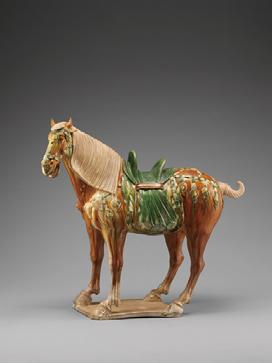
175 バイザーになっている。薮内流十世休々斎に学 んだ数寄者として、高橋箒庵著の『東都茶会記』 や『大正名器鑑』に記されている。 忠平の所持した茶道具は、孫にあたる忠良 (1887 1960)に引き継がれた。そして忠良自身 も蒐集家であったことから、上記の 2 点の茶碗 のほか、前田家伝来の灰 はい 蒙 かつぎ 天目(現イセ文化財 団蔵)、大津の鍵五郎伝来の金海茶碗などを所 持していたことが『大正名器鑑』に記されてい る。ちなみに、「宝樹庵」と「春日野」の2点 の名碗は、後に益田孝(1848 1938)の所有に帰 した。このように、松岡家は金沢では茶道具蒐 集家として高名で、多数の道具類が所蔵されて
る。大正から昭和にかけ各都市の美術倶楽部な どで華々しく開催された入札会では、当時の旧 大名家、華族、財閥、豪商などの所持品による 売立が毎年のように行われた。こうした入札で 大家は道具類を整理したのである。したがって、 これを開催できるのは富豪の証でもあった。松 岡家は、1929 年(昭和4)、1931 年(昭和 6)、 1933 年(昭和 8)の三回にわたり、金沢美術俱楽 部で『松岡家蔵品入札』を行っている。 挿図1 三彩馬 唐時代 高 67.0 cm 出光美術館 本作品は、おそらく忠良の時に入手したものと考えられ、後に、美術商瀬尾 商店からイセ文化財団の所有となり、その後大分県臼杵市の中國陶瓷美術館の 所蔵となるが、2011 年(平成 23)の常設展示室閉鎖にともないコレクションが 散逸した後、オークションで売却され、いったん中国人蒐集家の手許におさまっ たが、後に日本人の所蔵となり現在に至っている。 70 センチ級の大形の三彩馬は、数ある唐三彩のなかでも、高い評価と人 気を博している。わが国では、現在京都国立博物館に所蔵される一対の作品が 有名であり、これは 1921 年(大正 10)前後に将来されたと伝えられ、わが国の 大形三彩馬としては最初期の将来品であり、また代表作となっている。世界に
目を向けると、シカゴのフィールド自然史博物館が調査した高さ 80 センチの 馬が、1910 年に発見されたのが最も早い例とされる。その後、大形の三彩馬は、 蒐集の花形的存在として、戦前から長らく高い評価を誇っている。
近年では、1989 年 12 月にロンドンサザビーズで開催された「The British Rail Pension Fund」の売立に出品された高さ 76 センチの黒褐釉三彩馬が、当 時の中国陶磁のレコード・プライスである約 9 億円で落札された事例もあるほ どの人気で、これは日本人の所有となった。
本作は、大唐帝国の最も華やかな時代を象徴するような、量感に溢れた見事
白毛の汗血馬の迫力を漲らせている。まるでギリシャ・ローマの彫刻作品のよ うな張り詰めた空気を漂わせている。
三彩貼花鳳首瓶(図版14)
176
な作行きを示している。馬の口は開き、やや左に首を傾げる様は、一般的な馬 と比較すると、抜きん出た造形力を持し、胸や脚部の筋肉の表現は、唐時代の
これは、1938 年(昭和 13)1 月に雄山閣により出版された『陶器圖錄 第七 巻 支那篇(上)』に、当時の所有者であった繭山龍泉堂店主繭山順吉(1913 99)の名で掲載されている。名称の横には重要美術品と記されている。 これが重要美術品に認定されたのが、1937 年(昭和 12)12 月 24 日で、所有 者名は森村義行(1896 1970)となっている。繭山順吉の自著『美術商のよろこ び』によると、昭和 15 年頃に北京で入手し、その後に森村におさめたとあるが、 これは誤りで、記録によると 1937 年 2 月末に森村に納めたことになっている。 これらを総合して考えると、1937 年 2 月以前に繭山が北京で入手し将来、そ の後龍泉堂の当時の重要顧客の一人であった森村義行が購入した。『陶器圖錄』 掲載の所有者名が繭山順吉になっているのは、編集期間中で、まだ所有が移る 前であったのだろう。 森村義行は、公爵松方正義(1835 1924)の十二男として生まれ、京都帝国大 学法学部卒業後の 1921 年(大正 10)に、森村財閥を成した森村開作(7 代目市 左衛門、1873 1962)の婿養子となっている。1951 年、6 代目市左衛門(1839 1919)が 1910 年(明治 43)に創設した学校法人森村学園理事長・学長に就任。6
任している。
本作は、世界にある鳳首瓶のなかの白眉と言っても過言では ない。同じような貼花文のタイプでは白鶴美術館所蔵品(挿図2) が著名であるが、もう一つ、わが国で長らく個人所蔵となって いた作品がある(挿図3)。この瓶は、1912 年の『バーリントン・ マガジン(The Burlington Magazine)』第 21 号に紹介されており、 最も早くに市場に現れた唐三彩の本格派の一つとして貴重視さ

年

177 代目は、1904 年(明治 37)に日本陶器合名会社(現ノリタケカン パニーリミテド)の創業に携わった人物。前身の日本陶器は日本 で初めて高級洋食器を生産し、明治時代から戦前にかけて陶器 商社の森村組の手で欧米に大量に輸出されたことで知られ、義 行は、ノリタケの社長職にも就いている。 義行には、美術品蒐集の趣味があり、岸田劉生のパトロンの 一人であったことは有名で、また優れた浮世絵コレクションを 所持し、1968 年(昭和 43)に大和文華館で展覧会を開催している。 陶磁器の蒐集も旺盛で、この瓶を所蔵した昭和 10 年代には、 梅澤彦太郎(1893 1969)、井上恒一(1906 1985)、穂積重威 (1893 1959)、小池厚之助(1899 1985)らに並ぶ新進の中国陶 磁蒐集家としてその名を馳せ、本業の陶器会社の参考品もかね て、主に明・清代の五彩磁器の蒐集に注力した。陶芸趣味もあ り、自邸に窯を設け自ら作陶もしていた。こうした背景もあり、 1970 年(昭和 45)3 月、社団法人日本陶磁協会第2代理事長に就
れている。フランスの名美術商レオン・ワニエック(1875 1954) が取り扱ったとされ、1972
3 月に開催されたロンドンの美術 商エスケナージの展観図録の表紙を飾り、そこから繭山龍泉堂 が入手し、翌年個人蒐集家のもとにおさまったものである。翌 年の 1973 年 8 月刊行の『國華』第 960 号の巻頭で、三上次男に よって紹介されている。近年海外市場に流れ、現在はルーブル・ アブダビの所蔵となっている。 さて本作(図版 14)は、前述した『陶器圖錄』の第 31 図に掲 載されており、見開きの隣の右頁第 30 図には、現東京国立博物 館所蔵の重要文化財「貼花文龍耳瓶」(旧国宝)が掲載されている。 当時のわが国を代表する唐三彩として評価が高かったことが窺 挿図2 三彩鳳首瓶 唐時代 高 35.6 cm 白鶴美術館 挿図3 三彩鳳首瓶 唐時代 高 36.5 cm ルーブル・アブダビ © Department of Culture and Tourism – Abu Dhabi / Photo Herve Léwandowski
1938 年(昭和 13)11 月に開催された『東京
1923 年(大正 12)
の関東大震災で被害を受けた建物の復館を記念した国を挙げての重要な展覧会 であった。
前述した同類の二作品に比べると、本作は最も背が高いためか立ち姿が可憐 であり、貼花に派手さはないが、端正且つ大らかでバランス性に富み、エレガ ントな気品が漂う、高い美意識を持した逸品といえよう。
れ、わが国を代表する唐三彩として存在感を示している。
本展には、8 点に及ぶシカゴ美術館旧蔵品が出品されている。
先ず、図版 52「三彩印花鴛
鴦連珠文洗」、図版 65「藍彩碗」は、ケイト・スター ジェス・バッキンガム(Kate Sturges Buckingham、1858 1937)の旧蔵品である。
ケイト・スタージェス・バッキンガムは、オハイオ州ザーンズビルで生まれ、 恵まれた環境で大切に育てられ、そのなかで芸術に強い興味を持った。
シカゴ美術館との関わりは、兄クラレンスが、1893 年のシカゴ万博に出品さ れた日本美術に感銘を受け、浮世絵のコレクションに傾倒した頃から始まる。 彼女の母親が亡くなった 1898 年ケイトは 32 歳で、銀行、鉄鋼、不動産にまで 及ぶ莫大な富を管理することとなり、それ以降美術館への寄贈が始まるが、初 期コレクションは、障害のある妹ルーシー・モード・バッキンガムを喜ばせよ うと購入した鼻煙壺や、翡翠・ラピスラズリ・琥珀・磁器などでできたミニチュ ア人形であった。このようなささやかな始まりが、後に青銅器、陶磁器、日本 版画の素晴らしいコレクションへと成長した。
178 える。また、『陶器圖錄』刊行後の
帝室博物館復興記念陳列』展にも出品されている。これは、
戦後も、本編にある来歴のとおり、中国陶磁の主要な展覧会や図録に掲載さ
シカゴ美術館旧蔵の唐三彩
えんおう
1913 年に、シカゴ美術館の運営委員を 30 年間務め、評議員会のメンバーで あった兄クラレンスが亡くなり、その後を追うようにケイトは美術品蒐集を続 け、1920 年の妹ルーシー・モードの逝去後は、芸術の支援者としての役割を強 化していった。中国美術の多くをニューヨークで購入し、1921 年から 1938 年 にかけて、青銅器と古陶磁の大規模で印象的なコレクションが、妹ルーシー・ モードを偲んでシカゴ美術館に寄贈された。本作 2 点もこのときに入ったもの

179 である。 彼女のコレクションに対するスタンスは、包括的なアプロー チを取るよりも、自身が興味を感じ、美的にも知的にも魅力的 だと感じる作品を購入するというものだった。彼女の寛大な寄 付は、そのなかの何点かの名品、特に世界的にも知られている 青銅器の作品によって、シカゴ美術館の東洋コレクションの基 盤を形成したのである。 1935 年 11 月から翌年の 3 月にかけて、ロンドンのロイヤ ル・アカデミー・オブ・アートにて開催された未曽有の中国美 術大展覧会『中国芸術国際展覧会(International Exhibition of Chinese Art)』に、その貴重なコレクションの一端を、ルーシー・ モード・バッキンガムの名で貸し出しをしている。(挿図4) 図版 43「三彩鎮墓獣」、図版 50「三彩印花宝相華文洗」、図版 51「三彩印花飛鳥蓮葉文三足盤」、は、パーマー家による寄贈品 である。 パーマー家とシカゴ美術館との関係は、ポッター・パーマー (1826 1902)の妻であるバーサ・オノレ・パーマー(Bertha 挿図4 方彝 西周 高 32.8 cm シカゴ美術館 ルーシー・モード・バッキンガ ム コレクション © The Art Institute of Chicago / Art Resource, NY. ほうい Honoré Palmer、1849 1918)から始まる。1893 年のシカゴ万国博覧会開催準備 にあたり、バーサは女性管理職委員会会長の職に就き、1891 年から翌年にかけ ての旅行で多数の印象派をはじめとするヨーロッパ絵画を購入し、博覧会で新 設したギャラリーで展覧した。それ以降形成したヨーロッパ絵画のコレクショ ンは、バーサが亡くなった後に寄贈され、シカゴ美術館のこの分野のコレクショ ンの基礎となっている。歴代大統領たちと親交を深め、1900 年にはマッキンリー 大統領からパリ万国博覧会の唯一の女性委員に任命されるほど、シカゴの社会 的リーダーとして名声を轟かせた。 1902 年にポッターが死去し、バーサは、1500 万ドルという大きな資産を管 理するようになってから、彼女の洞察力と鑑識眼は中国陶磁や翡翠の蒐集に向 けられた。彼女の伝記作家の一人によると、「彼女の中国陶磁コレクションは 非常に希少な作品群で、彼女は唐の俑を初期に蒐集したアメリカ人の一人だっ た」とある。本作図版 43「三彩鎮墓獣」も、20 世紀初頭に出土した大形の俑 の一群の一つで、その作ぶりの良さから、彼女の高い鑑識眼をうかがうことが できる。その中国陶磁の主要な作品は、主に、当代を代表するロンドンの美術 商スパークスから手に入れている。また、1942 年 1 月 1 日に彼女のコレクショ
ンの売立が、ニューヨークのオークションハウスであるパーク・バーネットに よりおこなわれ、中国陶磁などが出品された記録が残っている。
1918 年バーサは死去するが、パリの邸宅には 533 点の中国陶磁と翡翠のコ レクションがあり、プロの鑑定家を必要とするほど大量であった。その貴重な コレクションは、第一次世界大戦の最中、パリを拠点とする美術商レオン・ワ ニエックが、パリからスペインへと逃亡した際、彼によって安全に移された。
これらのコレクションは、彼女の芸術への愛を受け継ぐ二人の息子、オノレ (1874 1964)とポッター・パーマー・ジュニア(1875 1943)に残された。彼ら
は継承したコレクションを維持するだけでなく、それぞれで自身のコレクショ ンも築き、二人もまたシカゴ美術館の熱心な支持者となった。オノレは、長 年にわたり美術館の理事を務め、ポッター・ジュニアは、1925 年から 1943 年 まで館長を務めた。若い頃、母親とパリのギャラリーや美術館を訪問した際 に刺激を受けた彼は、中国美術品の熱心なコレクターになり、上述した 1935 年から 36 年のロンドンの『中国芸術国際展覧会(International Exhibition of Chinese Art)』に 4 点の蒐集品を貸し出している。この展覧会に出品したコレ クターはいずれも当時世界屈指の蒐集家であった。ポッター・ジュニアは、そ の一人としてその名を刻んだのである。彼は、なかでも古代の工芸品を好み、 特に唐代俑に愛着を示したとされる。
オノレには、ポッター・ドルセイとオノレ 3 世の 2 人の子供がおり、ポッター・ ジュニアには、ポッター 3 世、バーサ(オークリー・L・ソーン夫人)、ゴードン、 ポーリーン(アーサー・M・ウッド夫人)の 4 人の子供がいた。彼らはその子 供たちとともに、継承した作品だけでなく、自身で新たに購入した作品も、シ カゴ美術館に惜しみなく寄贈し、ポッター家の「芸術を支援する」という名声
180
をより堅固なものにしている。 図版 4「三彩花文燭台」と図版 68「三彩華盤」は、ラッセル・M・タイソン (Russell M. Tyson, 1867 1963)の旧蔵品である。 ラッセルは、1867 年に上海で生まれる。彼の家族はラッセルがまだ一歳に なる前にアメリカ・ボストンに戻ったが、彼の幼少期の家に飾られていた数々 の中国美術品を覚えていた。 1890 年にハーバード大学を卒業後、1893 年にシカゴに移り住み、アルディス・ アンド・カンパニーの不動産業会社に入社し、この業界でそのキャリアを成功 させる。本格的にコレクションを始めたのは 1920 年に韓国を旅した際に数点 の韓国陶磁を手に入れてからで、それらは現在シカゴ美術館所蔵となっている。

181 ラッセルのシカゴ美術館への関与は 1920 年初頭に始まる。1922 年に設立さ れた東洋委員会の委員長を務め 1925 年から 1953 年までは理事を務めた。1958 年、新しく改装された東洋美術ギャラリーがオープンした際、シカゴ美術館理 事会は、彼の関心と寛大さに敬意を表するため、その一室に彼の名前を贈った。 その後、名誉評議員、名誉副会長となっている。 彼の主な蒐集対象は中国と韓国の陶磁器だったが、東洋美術全般に興味を示 し、しばしば彼の蒐集対象以外の作品購入のためにも博物館に資金を提供した。 彼は自身の好みと鑑識眼を満足させる美術品をもとめて、ロンドンやパリを巡 り、オークションやギャラリーを訪ねた。1940 年 3 月 28 日から 31 日にサザビー ズ・ロンドンで開催されたジョージ・ユーモルフォプスの売立では、美術商ジョ ン・スパークスを代理人として数点入手している。 上記の 2 点は、1951 年にシカゴ美術館へ寄贈したもので、「三彩燭台」は、 この手のなかでもトップ・クラスの作行を呈している。「藍彩華盤」は、白釉 と藍釉でデザインされた殊に稀有な作例で、実に瀟洒な一品である。 フェリーニ家旧蔵品の唐三彩 図版 3「三彩梅瓶」、図版 15「三彩万年壺」、 図版 16「三彩兔耳壺」、図版 25「絞胎鍑」、図版 40「黄褐釉加彩騎馬胡人」、図版 46「三彩胡服 童子」、図版 56「褐釉弦文壺」、図版 62「藍彩盒子」 は、ジャン・フランチェスコ・ジャクィリ・フェ リーニ(Gian Francesco Giaquili Ferrini)の旧蔵 品である。 この人物に関しては、資料がほとんどなく、 唯一といってよいものが、小山冨士夫によって 記された論文(参考文献参照)である。これによ ると、イタリアで特に優れた東洋古美術の蒐集 家として知られているのが、フェリーニ家であ る。もとメディチ家の別荘であったフローレン ス郊外の Villa “La Tana”にある豪壮な大邸宅に 挿図5 フェリーニ家の東洋古陶磁陳列室 「小山冨士夫「唐三彩」『古美術』創刊号, 三彩社, 1963年, p.36」より転載
朝俑、唐宋の名品が 200 点ほど並んでいたそうだ(挿図5)。このなかに唐三 彩の盤、瓶、俑などがあったという記述があるため、上記の8点も、当時そこ
182 参考文献 1 『Catalogue of the International Exhibition of Chinese Art 1935 6』Royal Academy of Arts London, 1936 年. 2 『陶器圖錄 第七巻 支那篇(上)』雄山閣 , 1937 年 3 高橋義雄編『大正名器鑑普及版』」第一編 , 寶雲堂 , 1937 年, pp. 2, 61 62 4 高橋義雄編『大正名器鑑普及版』」第六編 , 寶雲堂 , 1937 年, pp. 109 110 5 高橋義雄編『大正名器鑑普及版』」第七編 , 寶雲堂 , 1937 年, pp. 139 140 6. 『東京帝室博物館 復興記念陳列案内』帝室博物館 , 1938 年. 7. 小山冨士夫「唐三彩」『古美術』創刊号, 三彩社 , 1963 年, pp. 27 37. 8. 「Russell Tysonʼs obit in Chicago Tribune 23 July 1963」『Newspapers.com』 https://www.newspapers.com/clip/27468794/russell-tysons-obit-in-chicagotribune/ 閲覧日 2022 年 7 月 19 日 . 住むフェリーニ博士はよほどの大富豪らしく、たくさんの部屋部屋には古いイ タリア絵画・彫刻・調度がぎっしりと数限りなく飾ってある。階下の二室は東 洋古美術の小博物館になっており、その一室に、新石器時代の彩陶から漢、六
に飾られていたことだろう。 (かわしま ただし/繭山龍泉堂 代表取締役)
183 9. 井上昇三「奉悼森村義行先生」『陶説』第 213 号, 日本陶磁協会 , 1970 年, pp. 68 69. 10. 『 Inaugural Exhibition Early Chinese Ceramics and Works of Art 』 , Eskenazi, 1972 年. 11. 三上次男「唐三彩鳳首パルメット文の水注とその周邊」『國華』第 960 号, 朝日新聞社 , 1973 年, pp. 5 10. 12. 繭山順吉『美術商のよろこび』便利堂 , 1988 年. 13 高橋箒庵『東都茶会記 一』淡交社 , 1989 年, pp. 153 165, 173 176 14 高橋箒庵『大正茶会記 二』淡交社 , 1991 年 15 大石学「石川県立歴史博物館所蔵『大鋸コレクション松岡家文書補遺』目 録および解題」『東京学芸大学紀要, 人文社会科学系 . II』62:97 124, 2011 年(東京学芸大学リポジトリ https://core.ac.uk/download/pdf/15922713 pdf 閲覧日 2022 年 7 月 13 日) . 16 「 Kate Sturges Buckingham Was One of the Great Women in Chicago ʼ s History.」『Digital Research Library of Illionois History Journal』2018 年. https://drloihjournal.blogspot.com/2018/09/kate-sturges-buckingham-wasone-of-the-great-women-in-chicagos-history.html 閲覧日 2022 年 7 月 19 日 . 17. Roy Davids and Dominic Jellinek,『 Provenance. Collectors, Dealers & Scholars in the Field of Chinese Ceramics in Britain & America』 , Roy Divids, 2011 年 , pp. 344, 346 18. 『Important Chinese Art (Catalogue)』Sothebyʼs New York, 2019 年, pp. 146 147, 160 161, 168 169
Vignettes About Works in this Exhibition
Kawashima Tadashi
Some of the works displayed here carry with them intriguing provenance stories. In this essay I would like to introduce some of the fascinating vignettes that have accompanied these objects along their paths.
Sancai Horse (pl. 44)
This Sancai Horse was displayed in the Kaikan 5Shūnen ki'nen, Chūgoku no yakimono exhibition in 1964 commemorating the 5th anniversary of the opening of the Ishikawa Prefectural Museum. It was listed as belonging to the Matsuoka family of Kanazawa who had built their fortunes from the Edo period onwards as rice middlemen. Said to have been brought to Japan in the early Shōwa period, this horse was displayed as one of a pair alongside an amber-glazed work (fig. 1) of the same measurements and form. Both were in the Matsuoka family collection, but later the amber-glazed horse left the Matsuoka family and, via the offices of the art dealer Hirano Kotoken, is today in the Idemitsu Museum of Arts collection.
From the Edo period onwards the Matsuoka family had operated as Mattōya in the Jikkenmachi neighborhood of Kanazawa city. Their most active period spanned the Ansei to Keiō eras (1854 1868), a time when they also assisted the finances of destitute samurai.
The Meiji period head of the family Tadahira (忠平), born in 1837, was both rice middleman and the first head of the Kanazawa Rice Exchange starting in 1877. In 1888 his name was among those mentioned as the wealthiest people in Kanazawa city, and thus he solidified the family's fortunes and position in the rice trade. Tadahira was also a tea utensil collector, known to have acquired the meibutsu -designated Aoido Tea Bowl, known as Hōjuan , today in the Ishikawa Prefectural Museum of Art, for the massive sum of 800 yen, at a time when a university graduate bank employee could expect a starting monthly salary of
184
eight yen. This Aoido tea bowl purchase brought the name of Matsuoka of Kaga to the attention of the sukisha cultured elite of the time. He also owned the Aoido Bowl, known as Kasugano, today in the Yuki Museum, Osaka, which was dubbed one of the "three famous Aoido bowls of the eastern capital (Tokyo)."
Tadahira's younger brother Sanji (1846 1931) was also an antique art lover and highly regarded in Kanazawa not only as a collector but also as an appraiser, rising to the top of that field. His connoisseurship abilities were put to good use when he acted as collection advisor to his relative, a leading Kanazawa tea master named Yamakawa Shōtarō II (1862 1890). At the time the Yamakawa family owned Nonomura Ninsei's incense burner in the shape of a pheasant (National Treasure, Ishikawa Prefectural Museum of Art). Takahashi Sōan's Tōto chakaiki (東都茶会記) and the Taishō meiki kan (大正名器鑑) state that Sanji was a cultured gentleman who had studied the tea ceremony under Ky ū ky ū sai, tenth generation head of the Yabunouchi tea ceremony school.
Fig. 1 Sancai Horse. Tang dynasty. H. 67.0 cm. Idemitsu Museum of Arts.
Tadahiraʼs tea utensils were handed down to his grandson, Tadayoshi (1887 –1960) who was a collector. His activities as a collector are further described in the Taishō meikikan , which states that he owned the Maeda family-provenance hai-katsuki temmoku bowl (today in the Ise Cultural Foundation), and the kinkai -type koraijawan with Kagi Gorō of Ōtsu provenance in addition to the two renowned tea bowls. Those two bowls, Hōjuan and Kasugano, were later sold to Masuda Takashi (1848 1938). In this manner, the Matsuoka family became well-known tea utensil collectors in Kanazawa with a size able collection. Auction records also confirm this fact. Every year the massive number of art auctions held by the art clubs in major Japanese cities from Taishō through pre-war Shōwa eras saw the sale of objects then owned by former daimyō families, the aristocracy,

185
financiers and zaibatsu (financial combine) families, and wealthy merchants. These auctions were how such social and financial elites organized and honed their tea utensil and other artwork collections. Thus the holding of such auctions stood as proof of a collector's great wealth. The Matsuoka family held three auctions of works from their collection, the Matsuoka Family Collection Auctions held at the Kanazawa Art Club in 1929 (Shōwa 4), 1931 (Shōwa 6), and 1933 (Shōwa 8).
The Tang Sancai Horse displayed here is thought to have been acquired by the Matsuoka family during Tadayoshi's day and later entered the Ise Cultural Foundation collection via the art dealer Seo Shōten. It then entered the collection of the Chinese Ceramics Museum in Usuki city, Oita prefecture. That museum's permanent collection galleries were closed in 2011, which led to the dispersal of their collection, including later sales at auction. The Sancai Horse first entered a Chinese private collection before returning to the hands of a Japanese collector.
Sancai horses of the large 70 cm size are an extremely highly revered and prized sancai form. The pair of famous examples of this type today in the Kyoto National Museum are said to have been brought to Japan around 1921, making them part of the earliest arrivals of Tang sancai horses in Japan. They are also considered representative of their type. Globally, the Field Museum of Natural History in Chicago noted its study of an 80 cm tall horse that was discovered in 1910, making it the earliest recorded example of the type. Since then, large Tang sancai horses became a sought-after item for collectors and have boasted high appraisals since the pre-World War II era.
More recently, a 76 cm tall example with dark brown glaze appeared in an auction, the British Rail Pension Fund , held by Sothebyʼs London in December 1989, and it was so popular that it was sold for the then highest price for a Chinese ceramic object, approximately 900,000,000 yen, to a Japanese collector.
The work exhibited here is a splendid example, filled with the sense of volume that symbolizes the most magnificent period of the great Tang dynasty. The horse's mouth is open, its head somewhat turned to the left, reflecting an exceptional creative power versus that seen in ordinary examples of this ware type. In particular the expression of the musculature on the horse's chest and legs is an encapsulation of the compelling force of the Tang dynasty white Ferghana horse breed. This figure fills the space, exuding a sense of presence almost like that of antique Greek and Roman sculpture.
186
Sancai Phoenix Head Ewer with Applique Design (pl. 14)
This ewer was published in January 1938 in Yuzankaku's Tōki zuroku , vol. 7, Shina hen (jō), with the owner's name listed as Mayuyama Junkichi (1913 1999), then head of Mayuyama & Co., Ltd. The government's designation of the work as an Important Art Object (IAO) was noted next to its title.
This IAO designation was granted on December 24, 1937, with the owner's name listed as Morimura Yoshiyuki (1896 1970). Mayuyama Junkichi stated in his memoir, The Joys of an Art Dealer, that he acquired the work around 1940 in Beijing and that it was later owned by Morimura. But this is mistaken, with the records showing that Morimura acquired it at the end of February 1937. Thus, it was acquired by Mayuyama in Beijing before February 1937, and later was purchased by Morimura Yoshiyuki, then an important Mayuyama & Co., Ltd. client. The Tōki zuroku probably listed Mayuyama Junkichi as the owner of the work because the book was written and edited prior to the transfer of the work taking place.
Morimura Yoshiyuki was born the 12th son of duke Matsukata Masayoshi (1835 1924). After graduating from the law department at Kyoto Imperial University in 1921, Yoshiyuki was adopted by Morimura Kaisaku (1873 1962 , Ichizaemon VII), known for founding the Morimura zaibatsu . In 1951 Kaisaku became the chairman and principal of the Morimura Gakuen educational foundation established by Ichizaemon VI (1839 1919) in 1910. Ichizaemon VI was one of the founders of the Nihon Tōki G ōmei Gaisha in 1904, the predecessor to today's Noritake Co., Ltd. The predecessor company Nihon Tōki produced Japan's first high-grade, Western-style dishware and is known for exporting massive amounts of wares to the West from the Meiji period through the pre-World War II era via the offices of the ceramic merchants Morimura Gumi. Yoshiyuki also served as president of Noritake.
Yoshiyuki was an art collector, renowned as one of Kishida Ry ū sei's patrons, and also the holder of a superb ukiyo-e collection, which was exhibited at the Yamato Bunkakan Museum in 1968.
Yoshiyuki actively collected ceramics in the Shōwa 10 s, 1935 1945, a time when he acquired this ewer and became known as a leading Chinese ceramic collector. Other major Japanese collectors of that period included
187
Fig. 2
Sancai Ewer with a Phoenix Head. Tang dynasty. H. 35.6cm. Hakutsuru Fine Art Museum.
Umezawa Hikotarō (1893 1969), Inoue Tsuneichi (1906 1985), Hozumi Shigetaka (1893 1959) and Koike Kōnosuke (1899 1985). Yoshiyuki primarily collected Ming and Qing dynasty overglaze polychrome wares, including those for reference use in his own ceramic ware company. His interest in ceramics led him to build a kiln in his own home, where he created his own ceramics. Within this context he was named the second chairman of the Nihon Tōji Kyōkai in March 1970.
It would not be an exaggeration to say that the work displayed here is one of the finest phoenix head ewers in the world. A famous example with this same type of applique design (fig. 2) is today in the Hakutsuru Fine Art Museum. Another fine example had long been in a Japanese private collection (fig. 3). This then-private collection work was introduced in 1912 in The Burlington Magazine No. 21, and highly regarded as one of the earliest examples of full Tang sancai ware to appear on the market. It was handled by the famous French art dealer Léon Wannieck (1872 1954) and graced the cover of the catalogue for an exhibition held by the London dealer Eskenazi Ltd. in March 1972 . Mayuyama & Co., Ltd. acquired it from that exhibition. It entered a private Japanese collection the following year. Mikami Tsugio introduced it as the lead work in Kokka No. 960 published in August 1973. In recent years it was sold overseas and today is in the Louvre Abu Dhabi.
Fig. 3
Sancai Phoenix-Headed Ewer. Tang dynasty. H. 36.5 cm. Louvre Abu Dhabi.

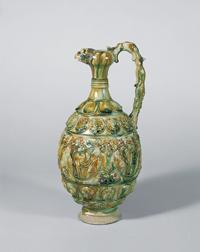
©Department of Culture and Tourism – Abu Dhabi / Photo Herve Léwandowski.
The Ewer displayed here as pl. 14 was published as pl. 31 in the Tōki zuroku , with the adjoining right page of the twopage spread displaying pl. 30, the Important Cultural Property (former National Treasure) designated Amphora style Vase with Dragon Handles and Applique Designs today in the Tokyo National Museum. That positioning indicates that this ewer was then highly regarded as a major example of Tang sancai ware in Japan. After its publication in Tōki zuroku , it was displayed in the important Tokyo Teishitsu hakubutsukan fukkō kaikan ki'nen chinretsu exhibition held in November 1938 to commemorate the repair of the museum's
188
structures damaged in the 1923 Great Kanto Earthquake.
When compared with the two previously mentioned similar examples, the ewer in this exhibition can be seen as a rare work with a lovely, balanced and fully symmetrical shape played out on the tallest body of the three, all factors that combine with its understated applique designs to create an elegant sensibility.
Tang Sancai Works Formerly in the Art Institute of Chicago
This exhibition displays eight works formerly in the Art Institute of Chicago collection.
First, pl. 52 , Sancai Basin with Stamped Mandarin Ducks and Pearl Circle Design , and pl. 65 Bowl with Blue Pigment , were both formerly in the collection of Kate Sturges Buckingham (1858 1937).
Ms. Buckingham was born in Zanesville, Ohio, and developed a strong interest in art as she grew up in a privileged environment.
Her connection to the Art Institute of Chicago began when her older brother Clarence became interested in the Japanese art displayed in the 1893 Chicago World's Columbian Exposition and started collecting ukiyo-e prints. When her mother died in 1898 Kate, then 32 years old, took up the management of a massive estate that included banks, steelworks and real estate, and began to make donations to museums. Her earliest collecting included snuff bottles and miniature dolls made of jade, lapis lazuli, amber and ceramics meant to amuse her invalid younger sister Lucy Maud Buckingham. From these gentle beginnings she then expanded into a splendid collection of ancient bronzes, ceramics and Japanese prints.
Clarence served for 30 years as an Art Institute of Chicago trustee and advisor before his death in 1913. Kate carried on art collecting, and after the death of her sister Lucy Maud in 1920, she further expanded her role as a patron of the arts. She purchased a large amount of Chinese art in New York, building an impressive collection of ancient bronzes and ceramics which she then donated to the Art Institute of Chicago in memory of her sister Lucy Maud between 1921 and 1938. The two works displayed here were part of that group.
189
Fig. 4
Wine Container, Western Zhou dynasty. H. 32.8 cm. Lucy Maud Buckingham Collection, The Art Institute of Chicago.
© The Art Institute of Chicago / Art Resource, NY.
Rather than taking a comprehensive approach to collect ing, Kate purchased works that suited her own interests and those which intellectually and aesthetically fascinated her. Her generous donation to the Art Institute included numerous masterpieces, and her ancient bronzes were particularly well known worldwide and helped form the basis of the Oriental collection at the Art Institute.
Part of that collection was loaned in the name of Lucy Maud Buckingham to the heralded International Exhibition of Chinese Art held at the Royal Academy of Art, London, from November 1935 through March 1936. (fig. 4)
Members of the Palmer family gave Sancai Tomb Guardian Beast (pl. 43), Sancai Basin with Stamped Hōsōge Flower Design (pl. 50) and the Sancai Tripod Tray with Stamped Flying Birds and Lotus Leaves Design (pl. 51) to the Art Institute of Chicago.
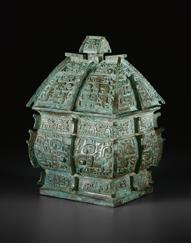
The connection between the Palmer family and the Art Institute of Chicago began with Bertha Honoré Palmer (1849 1918), wife of Potter Palmer (1826 1902). Bertha served as the President of the Board of Lady Managers who helped prepare for the Chicago World's Columbian Exhibition in 1893. Over the course of travels in 1891 to 1892 she purchased a large number of European paintings, including Impressionist works, which were then displayed in a newly built gallery at the World's Fair. The European painting collection she built after that event was donated to the Art Institute of Chicago after her death, forming the foundation for the museum's collection in that area. Bertha enjoyed close connections with several American presidents and was the only female member of the National Commission to the Paris Exposition named by President McKinley in 1900. All in all, Bertha was a leading figure in Chicago society.
Her husband Potter died in 1902 and it fell to Bertha to manage his $15 million estate. During the period that followed she turned her fine eye and acute perception to the collecting of Chinese ceramics and jade. According to one of her biographers, to paraphrase, her collection of Chinese ceramics was an extremely fine group, and she was one of the first Americans to collect Tang
190
figurines. The Tomb Guardian Beast shown here at pl. 43 is one of a group of large figurines excavated at the beginning of the 20th century and a clear example of her superb eye. Bertha acquired her important Chinese ceramic works primarily from the then leading London dealer John Sparks. Records remain of the Chinese ceramics included in the January 1, 1942 auction of her collection held by the New York auction house Parke-Bernet.
At the time of Bertha's death in 1918, there were 533 Chinese ceramics and jade works in her Paris home, a massive number that required a professional appraiser. In the midst of World War I, the Paris-based art dealer Léon Wannieck went into exile in Spain and safely transferred the works out of Paris.
Bertha's collection was inherited by her two sons, Honoré (1874 1964) and Potter Palmer Jr. (1875 1943) along with her love of art. They not only car ried on the collection they had inherited, they also built their own collections, and were dedicated supporters of the Art Institute of Chicago. For many years Honoré served on the Institute board of trustees, while Potter Jr. was Institute president from 1925 to 1943. As a young man Potter Jr. had been stimulated by his visits with his mother to galleries and museums in Paris, and he in turn became a fervent collector of Chinese art. He lent four works from his collection to the previously mentioned International Exhibition of Chinese Art held in London in 1935 36. All of the lenders to that exhibition were the top collectors of the time, and his selection for display in the exhibition confirmed his position within the top rank. He was particularly interested in ancient decorative arts, with a specific preference for Tang figurines.
Honoré had two children, Potter d ʼOrsay and Honoré III. Potter Jr. had four children, Potter III, Bertha (Mrs. Oakleigh L. Thorne), Gordon and Pauline (Mrs. Arthur M. Wood). Bertha's two sons and grandchildren were unstinting in their donation of her collection and those they had acquired themselves to the Art Institute of Chicago, further solidifying the name of the Palmer family as major patrons of the arts.
The Sancai Lamp with Floral Design (pl. 4) and Sancai Foliate Tray (pl. 68) were previously owned by Russell M. Tyson (1867 1963). Russell was born to an American family in Shanghai in 1867. They returned to Boston when he was less than a year old and he grew up surrounded
191
by the Chinese artworks that adorned his family home.
After graduating from Harvard in 1890, Tyson moved to Chicago in 1893, and there entered the Aldis & Co. real estate firm and built a flourishing career in real estate. He first began to actively collect when he acquired several Korean ceramics on a visit to Korea in 1920, and those works are now in the Art Institute of Chicago collection.
Tyson's connection with Art Institute of Chicago began in the early 1920 s. In 1925, he was named the chairman of the museum's Oriental Committee, which had been established in 1922 , and served as a museum trustee from 1925 to 1953. In 1958 the Art Institute of Chicago board of trustees named one of their newly established Oriental art galleries after Tyson in honor of his interest and generosity. He went on to be named an honorary trustee and honorary vice president for life.
While he primarily focused on Chinese and Korean ceramics, Tyson was interested in Asian art overall and often donated funds to the Institute for purchases of artworks outside of his specific areas of interest. He traveled to London and Paris, visiting auctions and art galleries, in search of artworks that satisfied his tastes and his eye. At the George Eumorfopoulos auction held by Sotheby's London on March 28 31, 1940, his representative, the art dealer John Sparks purchased several works on Tyson's behalf.
The two works mentioned here were donated to the Art Institute of Chicago in 1951, with the Sancai Lamp Stand considered one of the top class of its style. The Sancai Foliate Tray is a rare example of a work with designs formed in white glaze and blue glaze, and is a truly understated, elegant work.
Tang Sancai Works Formerly Owned by Gian Francesco Giaquili Ferrini
Eight of the works displayed here were formerly owned by Gian Francesco Giaquili Ferrini, namely Sancai Youth in West Asian Dress (pl. 46), Yellow Painted Amber Glazed West Asian on Horseback (pl. 40), Sancai Jar (pl. 15), Sancai Meiping Jar (pl. 3), Amber Glazed Jar with Shoulder Ridge (pl. 56), Sancai Jar with Rabbit Lugs (pl. 16), Marbled Clay Fu Tripod Vessel (pl. 25), and Box and Cover with Blue Pigment (pl. 62).
192
An essay written by Koyama Fujio (see bibliography) provides the best information I have located on Giaquili Ferrini. Koyama states that he was well-known in Italy as a collector of particularly fine Asian art. Giaquili Ferrini, who lived in the massive and magnificent Villa La Tana, originally a Medici family villa, on the outskirts of Florence, seems to have been extremely wealthy. His home was filled with countless examples of old Italian paintings, sculptures, and furnishings, with two rooms constituting a small museum of Asian antiques that contained around 200 fine works ranging from Neolithic painted pottery to Han and Six Dynasties figurines, and works from the Tang
Photo: Koyama Fujio, “Tōsansai”, Kobijutsu, No. 1, Sansaisha, 1963, p. 36. and Song dynasties. (fig. 5) Given that Koyama mentioned Tang sancai dishes, jars, and figurines among the displayed items, the eight I have listed above were probably among those displayed in those rooms.
(Kawashima Tadashi / President, Mayuyama & Co., Ltd.)

193
Fig. 5
Oriental Ceramic Room at Ferrini’s.
Japanese Period Dates
Meiji period: 1868 – 1912
Taishō period: 1912 – 26
Shōwa period: 1926 – 89
Reference Bibliography (in publication date order)
1 Catalogue of the International Exhibition of Chinese Arts, 1935 36 , Royal Academy of Arts, London, 1936.
2 Tōki Zuroku [Illustrated Ceramics Catalogue], vol. 7, Shina hen (jō) [China Vol. 1], Yuzankaku, 1937.
3 Takahashi Yoshio, Taishō meikikan fukyūban [Famed Tea Utensils of the Taishō Period, Standard Edition], vol. 1, Hōundō, 1937, pp. 2 , 61 62 .
4 Ibid., vol. 6 , Hōundō, 1937, pp. 109 110
5 Ibid., vol. 7, Hōundō, 1937, pp. 139 140
6 Tokyo teishitsu hakubutsukan fukkō ki'nen chinretsu annai [Guide to the Display Commemorating the Restoration of the Tokyo Imperial Museum], Tokyo Imperial Museum, 1938
7 Koyama Fujio, "Tō sansai" [Tang sancai], Kobijutsu Inaugural edition, Sansaisha, 1963, pp. 27 37
8 Russell M. Tyson obituary, Chicago Tribune, July 23, 1963, found on https://www.newspapers.com/clip/27468794 /russell-tysons-obit-in-chica go-tribune/ [retrieved July 19, 2022].
9 Inoue Shō z ō, "Hōtō Morimura Yoshiyuki sensei" [In Memoriam: Morimura Yoshiyuki], The Tosetsu No. 213, The Japan Ceramic Society, 1970, pp. 68 69.
10 Inauqural Exhibition Early Chinese Ceramics and Works of Art , Eskenazi, 1972
11 Mikami Tsugio, “A T ʼang Three-color Ewer with Applied Palmette Medallions and the Character of T ʼang Three-color Ware,” Kokka , No. 960, 1973, pp. 5 10.
12 Mayuyama Junkichi, The Joys of an Art Dealer, Benrido, 1988
13 Takahashi Sōan [Yoshio], Tōto Chakaiki 1, Tankō sha, 1989, pp. 153 165, 173 176
194
14. Ōishi Manabu, "Ishikawa kenritsu rekishihakubutsukan shoz ō 'Oga ko rekushon Matsuoka ke monjo hoi' Mokuroku oyobi kaidai", [Catalogue and explication of the Oga Collection Matsuoka family documents supplemental volume], Bulletin of Tokyo Gakugei University, Humanities and Social Sciences II, 62: 97 124, 2011. [Retrieved on July 13, 2022 from the Tokyo Gakugei University Repository: https://core.ac.uk/download/pdf/15922713.pdf]
15 Roy Davids and Dominic Jellinek, Provenance Collectors, Dealers & Scholars in the Field of Chinese Ceramics in Britain & America , Roy Davids, 2011, pp. 344, 346
16 "Kate Sturges Buckingham Was One of the Great Women in Chicagoʼ s History", Digital Research Library of Illionois History Journal , 2018. https:// drloihjournal.blogspot.com/2018/09/kate-sturges-buckingham-was-one-ofthe-great-women-in-chicagos-history.html [retrieved on July 19, 2022]
17. Roy Davids and Dominic Jellinek, Provenance. Collectors, Dealers & Scholors in the Field of Chinese Ceramics in Britain & America , Roy Davids, 2011, pp. 344, 346.
18. Important Chinese Art (Catalogue), Sotheby's New York, 2019, pp. 146 147, 160 161, 168 169.
Notes
- Japanese and Chinese personal names are presented in family name, personal name order, with Chinese names given in Pinyin or Wade-Giles romanization based on each person's local stardard usage.
- Where possible, published English versions of book and article titles are used. When no such published version is available, new English versions have been prepared for this volume.
195
Venue
03-3561-5146 2-5-9 Kyobashi, Chuo-ku, Tokyo, 104-0031, JAPAN TEL 03-3561-5146
https://www.mayuyama.jp E-mail: mayuyama@big.or.jp
Mayuyama & Co., Ltd
SANCAI EXHIBITION 唐三彩
and published by MAYUYAMA & CO., LTD. Published in October, 2022 Photographs by Tanaka Shigeyuki, Watanabe Mariko (technical cooperation) Japanese to English translation by Martha J. McClintock Chinese to Japanese translation by Takayuki Arai Designed by Studio Hart Printed by NEW COLOR PHOTOGRAPHIC PRINTING Co.,Ltd.,
MAYUYAMA & CO., LTD.
2022. Printed in Japan.
編集/発行:株式会社 繭山龍泉堂 発行年:2022年10月 写真:田中成之、渡邉まり子(協力) 英訳:Martha J. McClintock 中訳:新井崇之 デザイン:Studio Hart 印刷/製本:ニューカラー写真印刷株式会社 繭山龍泉堂© 2022 Edited
©
TANG
2022年10月14日(金) 〜 10月23日(日)
〒104-0031東京都中央区京橋2-5-9 TEL
★
★ 会場 /
本図録写真を、坂本万七寫眞研究所の内奥を受け継ぎ美術品写真家として繭山龍泉堂及び美術界に 多大な功績を残した故坂本守氏に捧げる。
